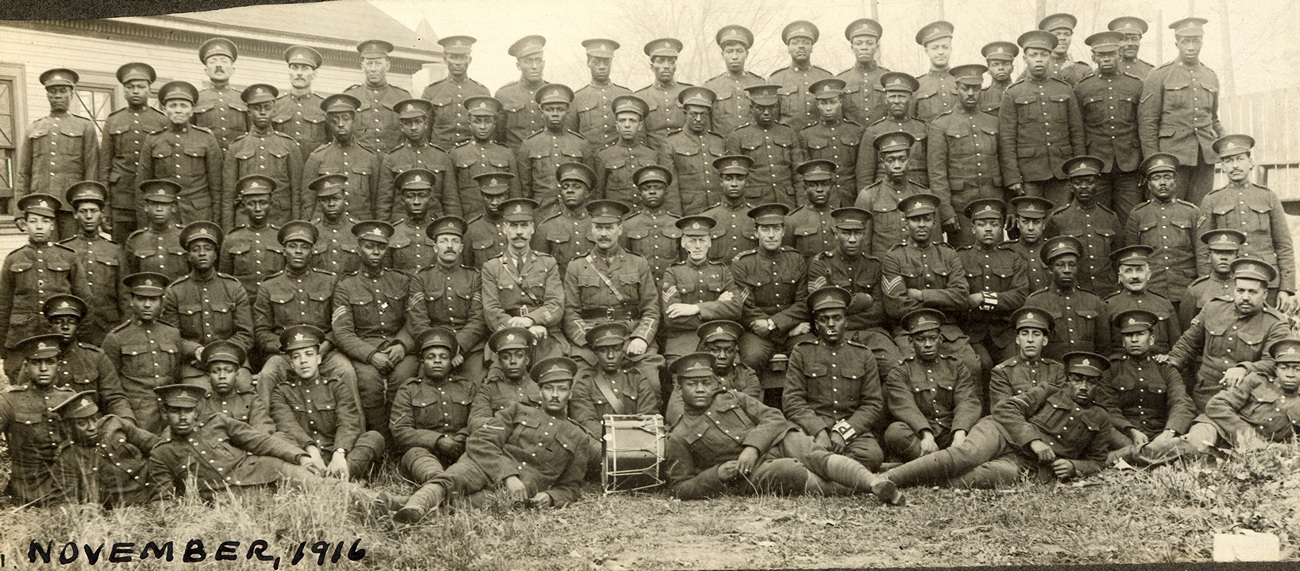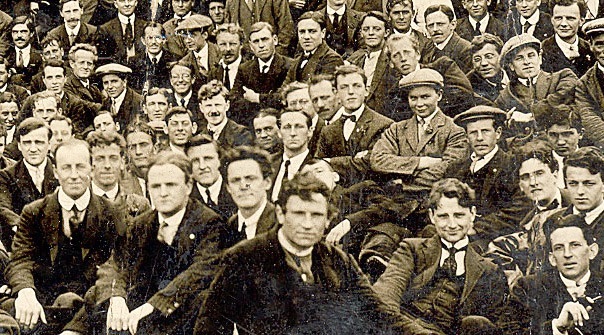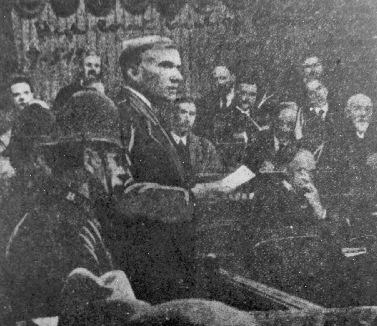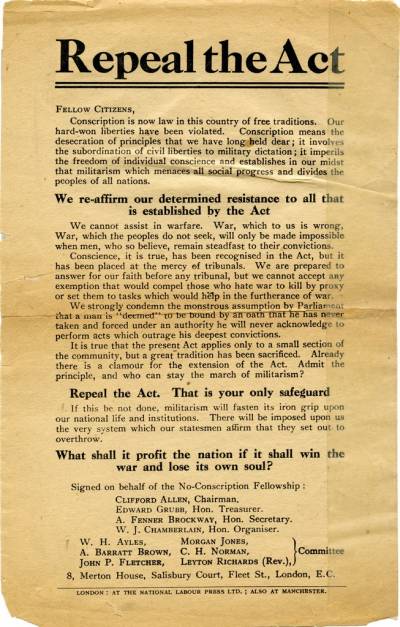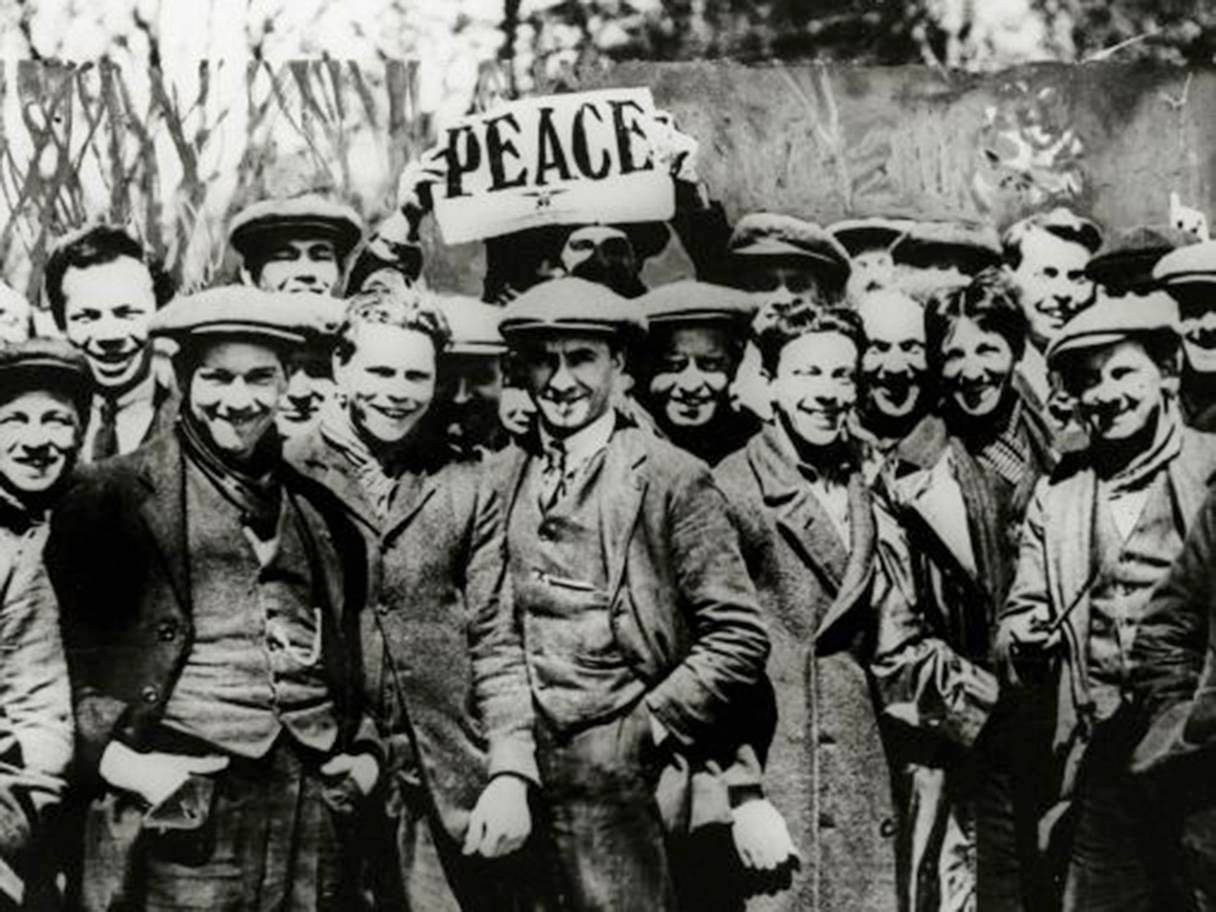No. 52
November 11, 2024
November 11, 2024
Remembrance Day
In
Wartime
Stephan
G. Stephansson
In Europe's reeking slaughter-pen
They mince the flesh of
murdered men,
While swinish merchants, snout in trough,
Drink
all the bloody profits off!
• The Time Has Come for Human Beings
to Make History
• The Day the Armistice Was Signed to End World War I
• Unacceptable Presence of NATO at Wreath-Laying Ceremonies! Get Canada Out of NATO! Dismantle NATO!
For Your Information on World War I
• Appeal to the Soldiers of All the Belligerent Countries
Canada
• War
Measures Act of
1914 and Internment of
Canadians
as "Enemy Aliens"
• Opposition to Conscription in Canada and Quebec
• Recruitment of Indigenous Peoples
• Black Construction Battalion
Britain
• British Movement of
Conscientious Objectors:
The Men Who Said
No
• Opposition in Britain to the War and Criminalization of Conscience
• Organizing to Oppose Conscription and
Defend
Conscientious Objectors
• Civil Service and Non-Combat Roles in
the Military
for Objectors
November
11, 2024
Remembrance Day
The Time Has Come for Human Beings
to Make History
As is well known, November 11 marks the day in 1918 when on the 11th hour of the 11th day of the 11th month, the armistice treaty which ended World War I was signed. Crocodile tears will be shed by the warmongers as they blame their adversaries and especially Russia which launched the Great October Revolution in 1917, took Russia out of the war and cancelled all unequal imperialist treaties. But they also use the occasion to blame Russia today as an avowed enemy. This despite the fact that the Soviet Union bore the brunt of the losses and damage caused during World War II in Europe, along with the working people of Europe, the Jews, the Roma, those the Hitlerites considered deviants, as well as the communists, anti-fascist resistance fighters and Soviet prisoners of war. They will have a very hard time this year presenting the U.S. as the champion of freedom, democracy and peace, as those who liberated Europe along with the British and, maybe, a few French and Polish aristocrats.
Already, the NATO Association of Canada has informed on its Instagram account that for November 11 this year, "we are proud to announce multiple NATO Wreath Laying Ceremonies across the country [...] in Vancouver, Ottawa, Montreal, and Toronto. [...] Join us in commemorating those who sacrificed greatly to protect the values we hold dear."
The Communist Party of Canada (Marxist-Leninist) resolutely opposes such attempts to militarize culture by militarizing wreath-laying ceremonies which honour Canadians and Quebeckers who were sacrificed as cannon fodder in World War I. Through sleight of hand, the NATO Association of Canada conflates all those whose lives were sacrificed in World War I, which was an inter-imperialist war for the redivision of the world, with those who fought Nazi Fascism in World War II and with the crimes NATO has committed since World War II and the U.S./NATO wars of destruction, regime change, and brutal war crimes they are committing today. This includes assassinations, torture, mass killings and now genocide in Gaza and massive destruction, displacement and killings in Lebanon. All of this, the NATO Association of Canada says uphold the values Canadians hold dear.
This is said at a time today when the U.S. democracy and the democracy of its Genocide Cartel, which includes Canada, and their claims to stand for peace, freedom and democracy, have never been so isolated on the world scale. Far from democracy, the U.S. election results show a country entering a period of police rule which is suffering profound psychological trauma, a profound existentialist crisis. So too the response of the ruling circles in Canada and Quebec to the election of Donald Trump as next president of the United States reflects the same thing. In Canada and Quebec, it is expressed in heightened hysteria about immigrants and refugees invading Canada, Trump imposing more tariffs on trade, more assaults on women and immigrants and the need to save Canada by walking in lockstep with the new U.S. administration.
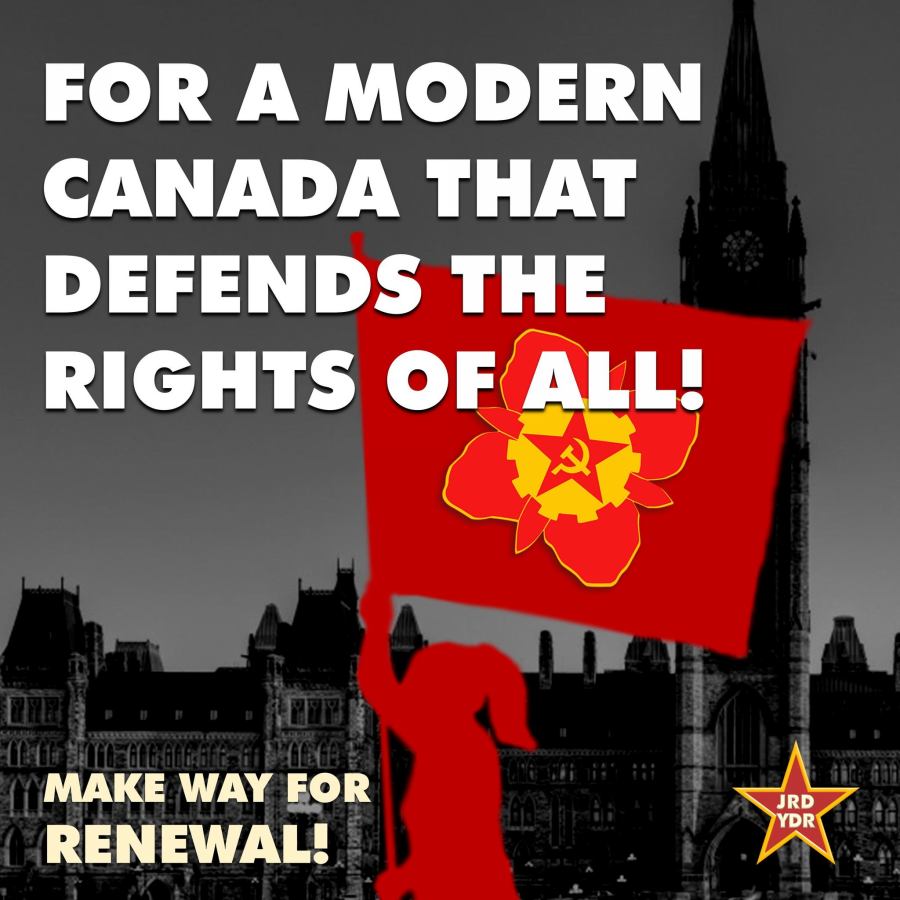 This
is a time to strengthen the work of CPC(M-L) and all Canadians,
Quebeckers and Indigenous Peoples to set another agenda, an agenda
which puts the claims they are within their rights to lay on society
which defend the rights of all, in first place.
This
is a time to strengthen the work of CPC(M-L) and all Canadians,
Quebeckers and Indigenous Peoples to set another agenda, an agenda
which puts the claims they are within their rights to lay on society
which defend the rights of all, in first place.
This is the
time to advocate for the mass democratic renewal of the electoral
process and a modern Constitution and support the modern conception
that our peoples' identities are and always have been forged in their
resistance struggle against exploitation, oppression, colonial rule and
Anglo-Canadian arrangements which deprive them of political power. A
people is not defined by the identity of two founding races imposed on
them first by the colonial power, and then sustained by the
Anglo-Canadian state to divide the people and permit Canada's
integration into the U.S. war machine and that of Quebec along with it.
Today, the dregs of the deposed ruling classes from the time of the Russian Revolution and the reactionary forces of this period continue to be consumed with a spectre of communism. It is a spectre which haunts them every time they engage in practices which go against the people's interests. They have created a stereotype of socialism and communism and defence of the rights of peoples of the world to wage resistance struggles against their enslavers and oppressors, which they equate with terrorism. The stereotypes are figments of their deranged imaginations, dominated by a morbid preoccupation with their own demise.
To keep the peoples out of power, the ruling elites of countries that espouse what is called "representative democracy" and its "liberal democratic institutions" push rule through ministerial prerogative powers that are exercised above the rule of law. This is then called a model of a democracy that should be imposed on others. It is a model which has no credibility whatsoever because you cannot both sanction genocide and claim to defend democracy. Meanwhile the so-called rules-based international order espoused by those who are backing genocide and war threatens to destroy any who refuse to submit to their dictate. At the same time, maintaining the use of veto power by a select few countries in the United Nations who are charged with defending the international rule of law, in actuality preserves power relations which keep entire peoples and nations out of power, and is used to shield those who commit genocide and their backers from being held to account.
Propaganda about the "enemy within" and "foreign interference" is used to divert the attention of the workers and peoples of the world both from how decision-making takes place within what are called the paradigms of democracy, and how to create a system which is able to effectively channel all the human and material resources of their countries in a manner which favours them.

It is most obvious today with attempts to impose governments of police powers as the U.S. imperialists and their allies, including Canada are doing, as well as the Legault government in Quebec and provincial governments across the country. Never has the system called a representative democracy and its claims been so isolated on the world scale as is the case today. An order is not something which can be imposed from above.
In fact, the more the counterrevolution launched since the fall of the former Soviet Union deepens, the more the significance of the Great October Socialist Revolution to human history increases. Since the collapse of the former Soviet Union in 1989-91 as a result of the restoration of capitalism in that country and imposition of a rule which deprived the people of Soviet power, the consequences of the U.S.-led brutal neo-liberal anti-social offensive and the wars it has unleashed to achieve regime change and domination continue to cause tremendous damage to the peoples of the world and Mother Earth. The crimes of the U.S. and its allies today are unprecedented. Those committing these crimes include Canada, Britain, Australia and New Zealand. Their intelligence agencies together with those of the U.S., make up the so-called "Five Eyes" political police services which are dictating policy which permits the takeover of the state by police powers and criminalization of the people in the name of "values." It is only the peoples striving for their own empowerment who can bring this state of affairs to an end.
In the conditions of the retreat of revolution, the extreme violence unleashed by the U.S./Zionist killing machine in Gaza, as well as the U.S./NATO proxy war in Ukraine and in other countries of the world is a state of affairs possible because the initiative is not in the hands of the peoples. So long as the big powers by entering into cartels and coalitions with other countries are expected to stop it, the suffering of the peoples will continue to increase.
The current international system is discredited because it does not stop the violence, the killings, the threats of expanded war. Thus, the peoples are supporting the Resistance Movements, expressing confidence that they will open a way forward which vests sovereignty in the people, not ruling elites.
What it means to have a society such as the one which came into being in 1917 in Soviet Russia is once again relevant. Soviet Russia created a new society by establishing Soviet power which put the initiative in the hands of the workers, peasants and patriotic intelligentsia. It put the building of a revolutionary party of the working class on the basis of Soviet power at the centre to make sure the workers were educated and trained to decide all matters of concern in a manner which favoured their interests and then they led the masses of the people to do likewise. This is what is to be achieved today on a new basis, with the people working as one to provide the rights of all with guarantees of their own making.
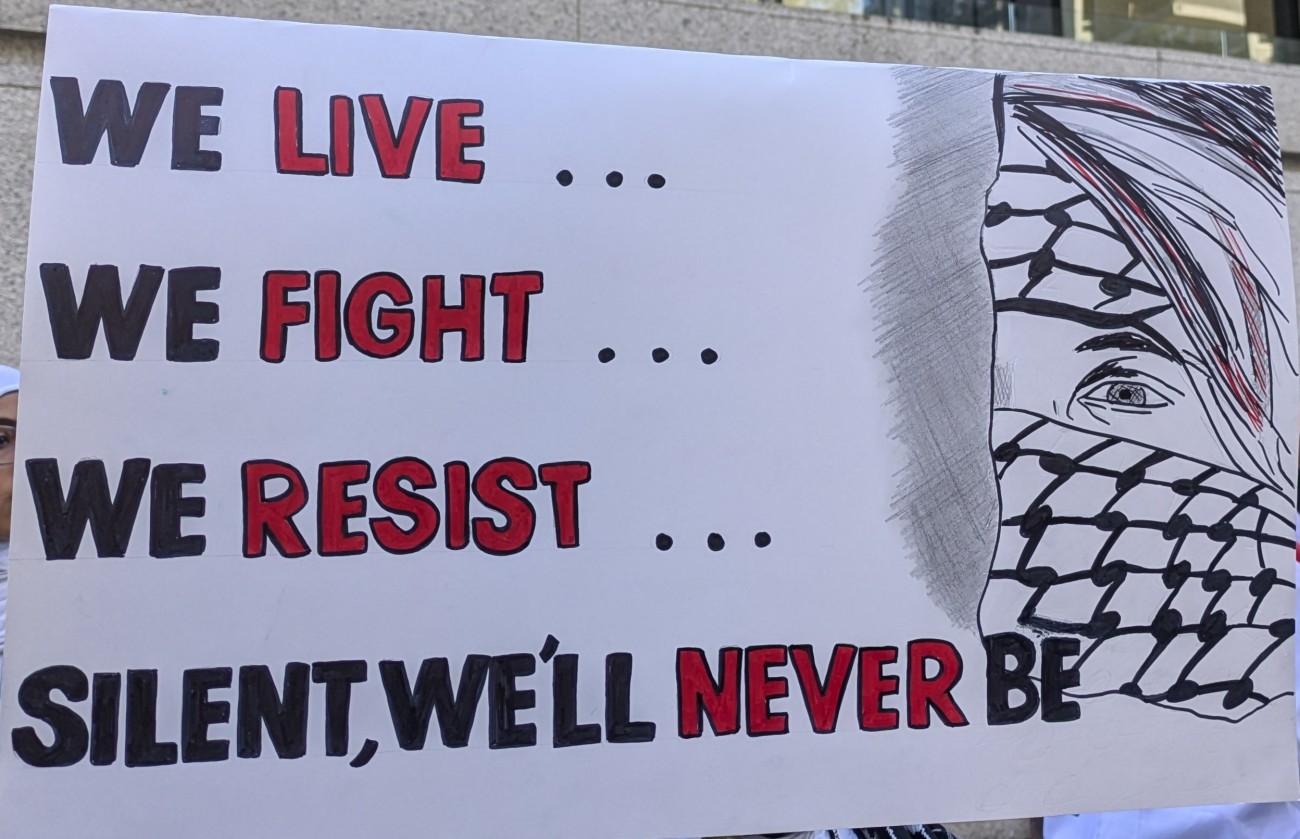 On this occasion,
we salute all those who have waged and continue to
wage a courageous resistance in our country. This includes not only the
workers from all sectors of the economy, the self-sacrificing health
care personnel, teachers and education workers and peoples in the towns
and villages
giving their all to stop the privatization and sellout of our resources
but importantly, the youth and all those speaking in their own names to
support the Resistance movements in Palestine, Lebanon, Haiti, Cuba,
India and all countries of Asia, Africa, Latin America, the Caribbean,
Oceania, Europe
and the United States.
On this occasion,
we salute all those who have waged and continue to
wage a courageous resistance in our country. This includes not only the
workers from all sectors of the economy, the self-sacrificing health
care personnel, teachers and education workers and peoples in the towns
and villages
giving their all to stop the privatization and sellout of our resources
but importantly, the youth and all those speaking in their own names to
support the Resistance movements in Palestine, Lebanon, Haiti, Cuba,
India and all countries of Asia, Africa, Latin America, the Caribbean,
Oceania, Europe
and the United States.
The peoples are on the cusp of making great headway in humanity's fight to turn things around in their own favour but these are trying times which contain great dangers. We must strengthen ourselves by taking up the program of organizing the people on a new basis.
As we commemorate all the lives lost in World War I, the Duty of Memory leads us to draw the conclusion that we must all work hard to strengthen the mass movements for peace, freedom and democracy. We must strengthen the work to build a mass communist revolutionary party which trains its members in mass democratic methods of work and decision-making. Such a party must be capable of creating transitional forms of organization within all spheres of endeavour, also based on mass democratic ideological and political mobilization which empowers the working class and people to take the decisions on all matters which affect their lives.
The Day the Armistice Was
Signed
to End World War I
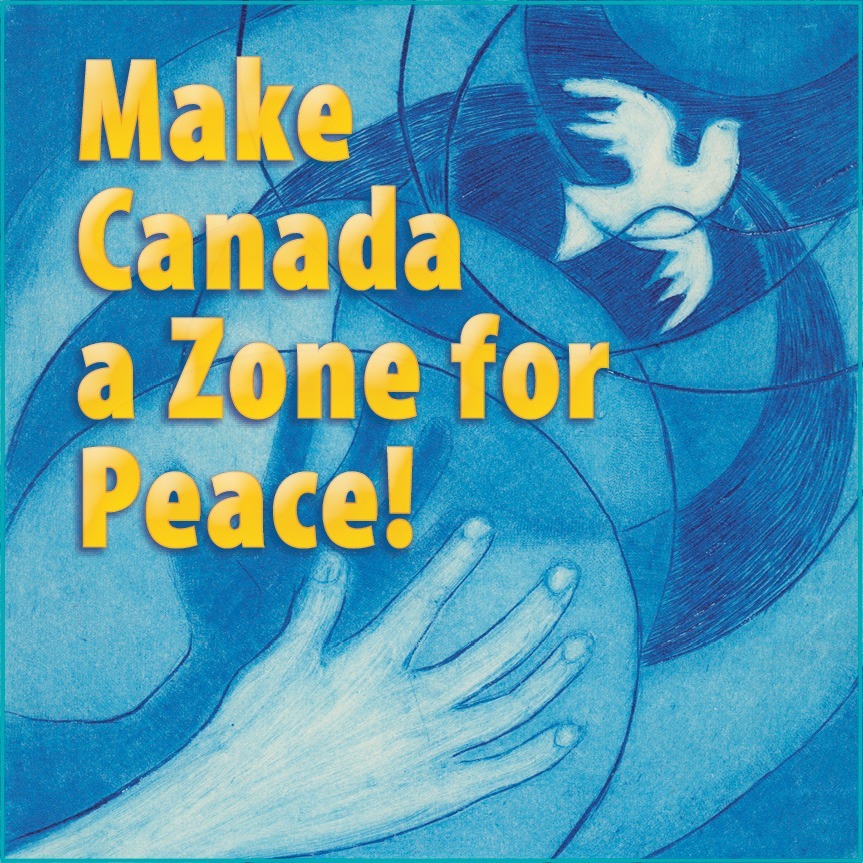 On November 11,
1918, the Armistice which brought World War I to an end was signed,
marking the end of the war. A slaughterhouse of unprecedented
proportions, World War I was referred to as the "war to end all wars."
The Treaty of Versailles was finally signed by Germany and the Allied
Nations on June 28, 1919, formally ending World War I.
On November 11,
1918, the Armistice which brought World War I to an end was signed,
marking the end of the war. A slaughterhouse of unprecedented
proportions, World War I was referred to as the "war to end all wars."
The Treaty of Versailles was finally signed by Germany and the Allied
Nations on June 28, 1919, formally ending World War I.
World War I was an inter-imperialist war, a war in which working men were sent to be slaughtered as empires clashed to re-divide the world. World War I left 9 million soldiers dead and 21 million wounded. In addition, at least 5 million civilians died from disease, starvation, or exposure. The influenza epidemic that swept the world in 1918 killed an estimated 50 million people. One fifth of the world's population was attacked by this deadly virus.
The war also marked a turning point in history. In 1917, the Russian working class and people organized the Great October Socialist Revolution and took Russia out of the war.
When Soviet power was established, Winston Churchill called for the crushing of the baby "in the cradle." In the aftermath of the war, 14 foreign powers, including Canada, militarily intervened in order to foment civil war, seize Soviet Russia's assets for themselves and put an end to the revolution and Soviet power. But Soviet power prevailed and they were defeated. Far from being crushed, the Great October Socialist Revolution led to the advance of society, to its vigorous development and the unprecedented release of human initiative.
Drastic political, cultural, economic, and social change occurred in Europe, Asia and Africa, even in areas outside those directly involved. Four empires collapsed due to the war -- the Russian Czarist Empire in 1917 and then the Ottoman Empire, the German Empire and the Austro-Hungarian Empire in 1918. Old countries were abolished, new ones were formed and boundaries were redrawn. The League of Nations was established in 1919, under the Treaty of Versailles "to promote international cooperation and to achieve peace and security."
The high ideals of a "War to End All Wars," of duty to King and Country, and to empire, were shown to be a cover, a false justification, for the horrendous clash of the imperialist warmongers which took place during World War I. Yet these same values are promoted at this time under the rubric "Lest we forget."
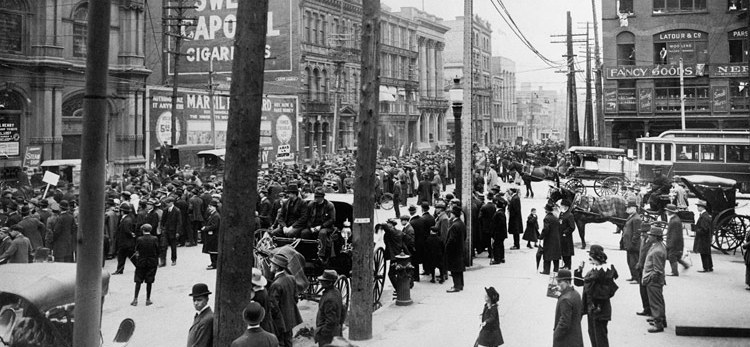 Demonstration against conscription
in Victoria Square, Montreal, May 17, 1917. Working people in Quebec
could find no convincing reason to sacrifice their lives for the glory
of the British Empire. The Canadian government imposed conscription in
August 1917.
Demonstration against conscription
in Victoria Square, Montreal, May 17, 1917. Working people in Quebec
could find no convincing reason to sacrifice their lives for the glory
of the British Empire. The Canadian government imposed conscription in
August 1917.
Bourgeois historiography refers to Canada's "coming of age" as a result of its role in World War I where it allegedly proved itself worthy of making decisions over its own foreign policy. The sacrifice of Canadian youth as cannon fodder in the trenches of Europe is said to have provided proof that Canada could be entrusted with the conduct of its own foreign policy and break ties with the British Imperial Parliament in this regard. This disinformation seeks to imbue Canadians with a chauvinist outlook that portrays Canada as a major Entente Power fit to sit at the table that divides the spoils of war. In fact, it made Canada a yes-man at the service of the understandings between Britain and France to keep Germany out, while they sympathized with all the new organizations hostile to Soviet Russia.
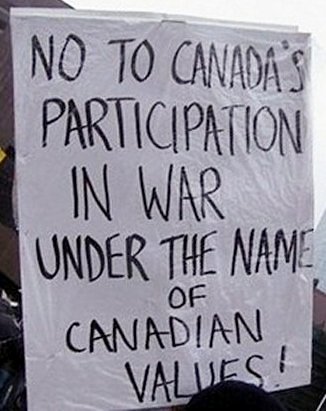 Today, Canada's
warmongering is presented as a foundational Canadian value. But the
sacrifice of Canadians contradicts official accounts. Their sacrifice
was made not for freedom but on behalf of empire. Canada's independence
was not secured by sending Canada's youth to participate in the charnel
house of imperialist slaughter that was World War I, a war of division
between the empires of the day to secure sources of raw materials,
cheap labour, zones for the export of capital and strategic influence.
On the contrary, Canada's ruling elite secured a place for itself as a
yes-man of first the
British and then the U.S. imperialists, while the movement of the
people persists for a genuine nation-building project in which the
natural and human resources and decision-making power serve the people,
not the rich.
Today, Canada's
warmongering is presented as a foundational Canadian value. But the
sacrifice of Canadians contradicts official accounts. Their sacrifice
was made not for freedom but on behalf of empire. Canada's independence
was not secured by sending Canada's youth to participate in the charnel
house of imperialist slaughter that was World War I, a war of division
between the empires of the day to secure sources of raw materials,
cheap labour, zones for the export of capital and strategic influence.
On the contrary, Canada's ruling elite secured a place for itself as a
yes-man of first the
British and then the U.S. imperialists, while the movement of the
people persists for a genuine nation-building project in which the
natural and human resources and decision-making power serve the people,
not the rich.
Today, more than 100 years after the end of World War I, Canada has been integrated into the U.S. imperialist war machine while the U.S. and NATO and their allies expand their interference and aggression and threaten war against countries that will not submit to their dictate. At the same time, the Canadian government, in the service of this agenda, is setting the stage to use its police powers to deem opposition to war and aggressive alliances such as NATO as threats to national security.
Today, Canadians and Quebeckers stand second to none amongst the peoples of the world opposing genocide and imperialist aggression and war. They have done so by arguing out their convictions in the face of an onslaught of disinformation that the brutal crimes carried out by U.S. imperialism, NATO and Zionism represent enlightenment, defence of human rights, peace, democracy and freedom. The peoples' ongoing work to oppose these crimes and end Canadian complicity is part and parcel of the important work to bring about new arrangements that will Make Canada a Zone for Peace.
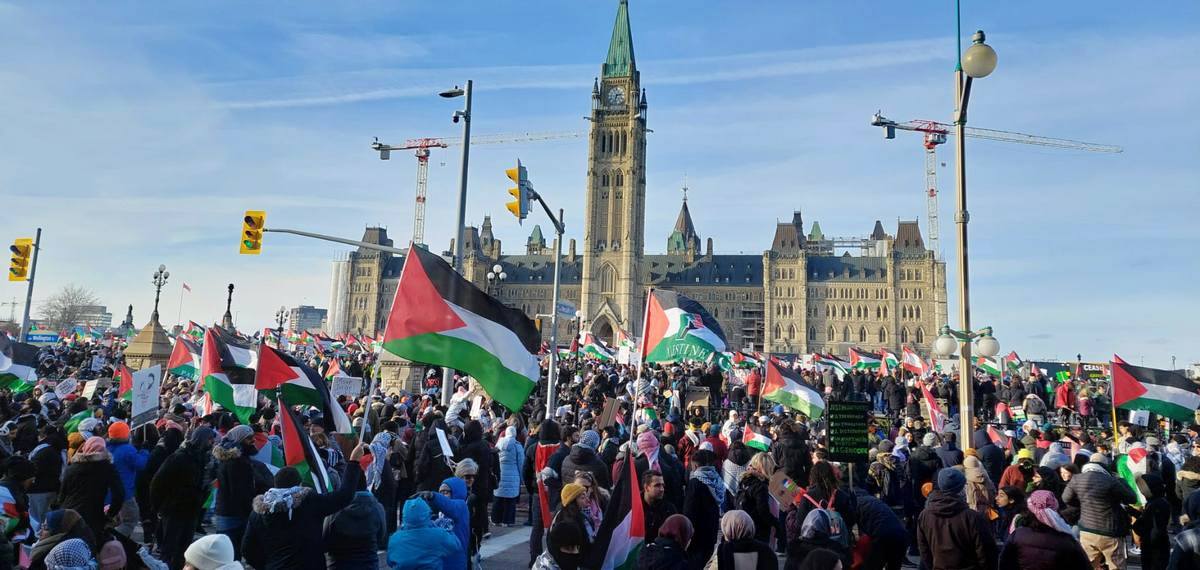
First National Day of
Action against the U.S./Israeli genocide in Palestine, November 25, 2023
Unacceptable Presence of
NATO
at Wreath-Laying Ceremonies!
Get Canada Out
of NATO! Dismantle NATO!
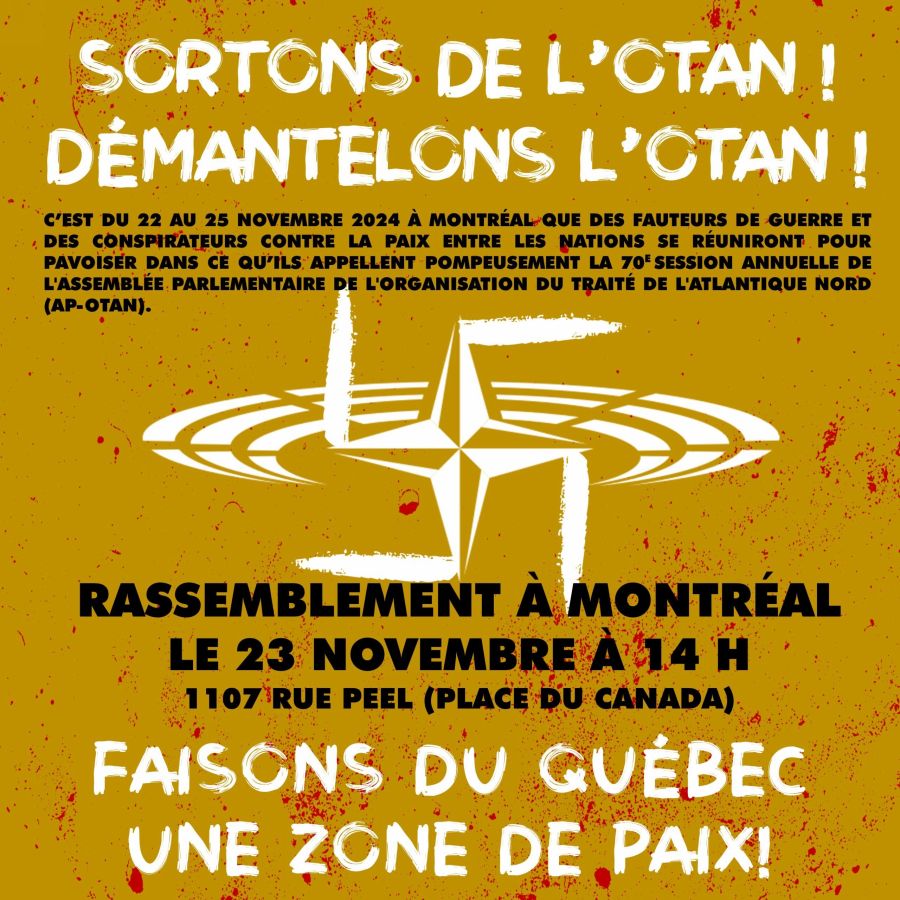 The NATO Association
of Canada informed on its
Instagram account that this year for November 11, "[W]e are proud to
announce multiple NATO Wreath Laying Ceremonies across the country
[...] in Vancouver, Ottawa, Montreal, and Toronto.[...] Join us in
commemorating those who sacrificed greatly
to protect the values we hold dear."
The NATO Association
of Canada informed on its
Instagram account that this year for November 11, "[W]e are proud to
announce multiple NATO Wreath Laying Ceremonies across the country
[...] in Vancouver, Ottawa, Montreal, and Toronto.[...] Join us in
commemorating those who sacrificed greatly
to protect the values we hold dear."
The presence of NATO -- a warmongering alliance led by the U.S. imperialists that is currently armed to the teeth in Europe and waging a U.S. proxy war in Ukraine -- at wreath-laying ceremonies to remember those who perished in World War I, is unacceptable. NATO's values are the opposite of what those Canadians who were used as cannon-fodder by the British in that war upheld. The ceremonies also commemorate those who perished in World War II. Here as well, NATO falsely claims to represent the aspirations of those who fought and died as part of the united anti-fascist front of the peoples. Its claims are bogus because it was founded on an anti-communist basis that put Nazi war criminals in charge of its operations. Thus, it is similarly unacceptable that NATO is welcomed to honour those who made sacrifices to eliminate the scourge of fascism.
To show what NATO stands for, we are republishing below an article by Dougal MacDonald titled "U.S. Built NATO by Putting Nazi War Criminals in Charge," originally published by TML Daily on March 28, 2022.
U.S. Built NATO by Putting Nazi War Criminals in Charge
As the situation in Ukraine develops, imperialist propaganda continues to promote the false notion that NATO (and by default the U.S.) is somehow an alliance for peace. This fraud is being perpetuated to try to convince people that the situation in Ukraine can be boiled down simply to "bad" Russia on one side and "good" U.S. and NATO on the other. Therefore, everyone should support the U.S. and NATO and oppose Russia and that will somehow bring about peace on earth.
Aside from the fact that the whole history of the U.S. and NATO focuses on war against other countries rather than peace, this big lie is also refuted by the history of NATO itself.
The facts show that as soon as the Hitlerites surrendered at the end of the Second World War, with the Soviet Union playing the main role in their defeat, the Anglo-Americans began helping Germany rebuild, economically and militarily. Germany was to serve as a bulwark against the socialist Soviet Union, the Anglo-Americans' supposed wartime ally, now designated their main foe. This post-war plan, which was already being hatched before the war ended, included the formation of the aggressive NATO alliance in 1949 within which a number of Hitler's military leaders played key roles.
|
One typical example is General Adolf Heusinger, a career military officer who, with the outbreak of the Second World War, became part of the German headquarters field staff and helped plan the Nazi invasions of Poland, Denmark, Norway, France and the Low Countries. The Nazis perpetrated against Poland one of the worst crimes history has ever known. Poland suffered the largest number of casualties per capita of any European country, with a total of about six million people killed. Heusinger rose quickly through the Wehrmacht's administrative ranks and in 1944 was appointed Adolf Hitler's Chief of the General Staff of the Army.
After the war, Heusinger was interrogated by the Americans but not put on trial. A declassified CIA document says: "Upon surrendering to U.S. Army authorities in May 1945, the question of [Heusinger's] implication as a war criminal arose in connection with certain orders he signed and forwarded which sealed the fate of captured Russian political indoctrination officers and Allied commandos. However, in view of Heusinger's cooperative attitude at Nuremberg and the fact that he had only initialed the orders in transmittal, no action was undertaken. Instead, Heusinger served as a research consultant without pay for the Office of the United States Chief of Counsel for War Crimes at Nuremberg periodically between 1945 and 1948."
So instead of being put on trial for war crimes, Heusinger became an advisor on military matters to Konrad Adenauer, appointed the first Chancellor of West Germany in 1949. One of Adenauer's first acts was denunciation of the denazification of Germany and an amnesty for Nazi war criminals. By the end of January 1951, almost 800,000 war criminals had benefited from the amnesty. Adenauer and John J. McCloy, U.S. High Commissioner for Germany and later Chairman of the Rockefellers' Chase Manhattan Bank and the Ford Foundation, were linked by marriage. McCloy played a key role in the early release from prison of many Nazi war criminals convicted at Nuremburg, including industrialists Alfried Krupp and Friedrich Flick who went right back to enriching themselves by taking leading roles in the post-war German economy.
With the 1955 establishment of the Bundeswehr, the reconstituted West German Armed Forces, Heusinger returned to military service, and was appointed Lieutenant-General in 1955. In 1957, he was promoted to full general and named the first Inspector-General of the Bundeswehr. He served in that capacity until 1961. In 1961, Heusinger was appointed Chairman of the NATO Military Committee, making him the senior military spokesperson for NATO and in 1963 he also became NATO's chief of staff, serving in that capacity until 1964.
Many other prominent ex-Nazis followed similar paths, in particular serving as Commanders in Chief of Allied Central Forces Europe. Here are just a few examples:
- General Hans Speidel, who participated in the invasions of Poland, France, and the Soviet Union, played a key role in German rearmament and integration into NATO, and in 1957 became Commander-in-Chief of Allied Forces Central Europe.
- Sturmführer Dr. Eberhard Taubert worked with Goebbels in the Nazi Ministry of Propaganda where he was responsible for designing the yellow badge for Jews. After the war, he eventually became an adviser to ex-Nazi Franz Josef Strauss, German Minister of Defence from 1956-62, and was assigned by Strauss to NATO's "Psychological Warfare Department" which spewed anti-communist propaganda just as Goebbels' ministry had during the war.
- Nazi Admiral and U-Boat commander Friedrich Guggenberger, whose U-boat sank 17 allied ships, later served as Deputy Chief of Staff in the NATO command Armed Forces North (AFNORTH), 1968-72.
- Johannes Steinhoff, a Luftwaffe fighter pilot, was made Chairman of the NATO Military Committee 1971-74, holding other NATO positions prior to that.
- Johann von Kielmansegg, General Staff officer to the High Command of the Wehrmacht, 1942-44, was NATO's Commander in Chief of Allied Forces Central Europe, 1967-68.
- Ernst Ferber, a major in the Wehrmacht, was NATO's Commander in Chief of Allied Forces Central Europe, 1973-75.
- Karl Schnell, First General Staff officer of the LXXVI Panzer Corps, was NATO's Commander in Chief of Allied Forces Central Europe, 1975-77.
- Franz Joseph Schulze, Chief of the Third Battery of the Flak Storm Regiment 241, was NATO's Commander in Chief of Allied Forces Central Europe, 1977-79.
- Ferdinand von Senger und Etterline, Lieutenant of the 24th Panzer Division of the German Sixth Army, was NATO's Commander in Chief of Allied Forces Central Europe, 1979-83.
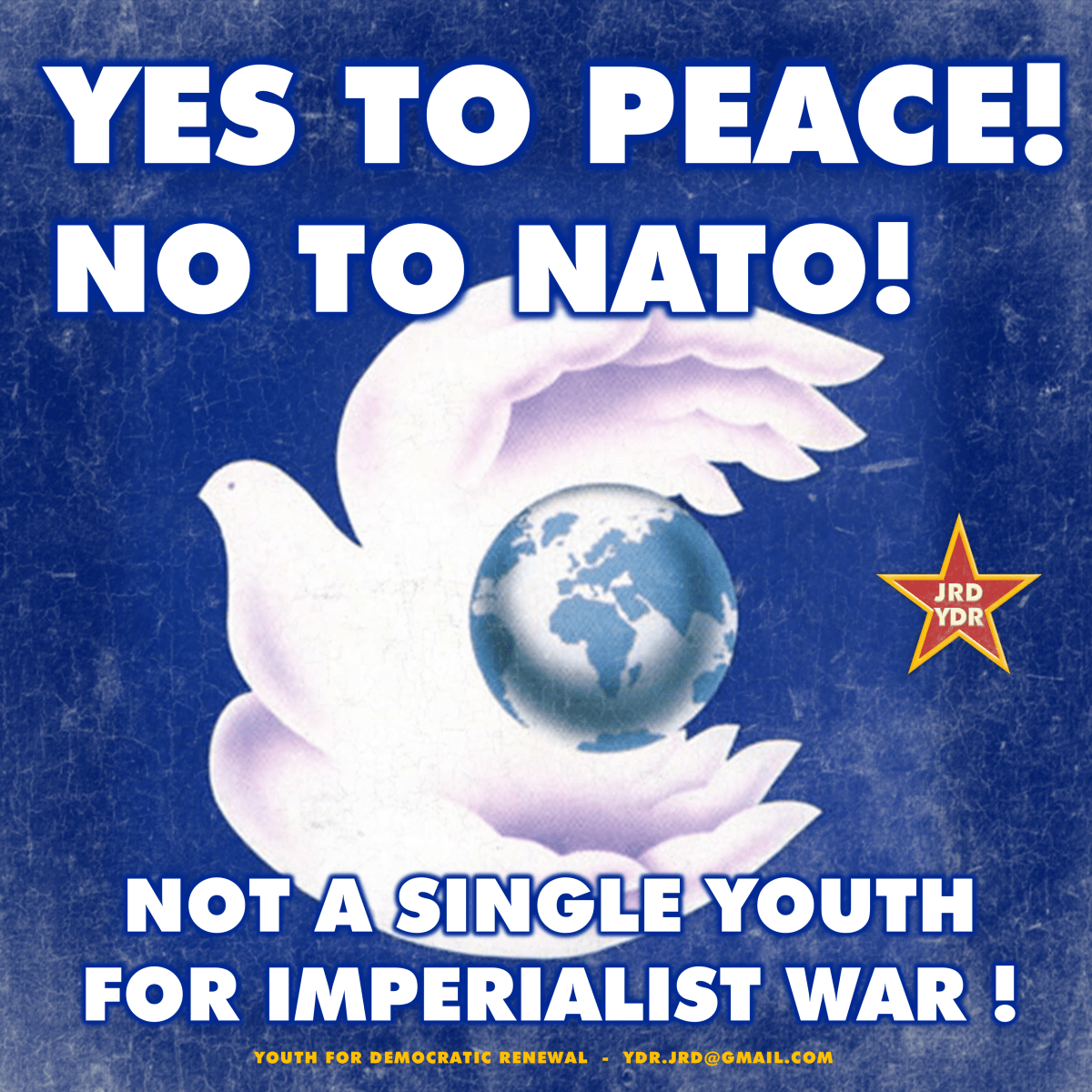 The historical
facts are clear. Instead of facing trial and
paying for the countless crimes they planned and committed, Heusinger,
Speidel and other prominent Nazi war criminals were given a free pass
by the Anglo-Americans. Instead of being made accountable, they were
rewarded for their service
to the Nazis by being given key roles in rebuilding the West German
army to oppose the Soviet Union and by being appointed as key NATO
functionaries in Europe for the same nefarious purposes. There is a
clear connection from the Nazis to the U.S. occupiers to the West
German military to NATO that
once again exposes NATO's true role.
The historical
facts are clear. Instead of facing trial and
paying for the countless crimes they planned and committed, Heusinger,
Speidel and other prominent Nazi war criminals were given a free pass
by the Anglo-Americans. Instead of being made accountable, they were
rewarded for their service
to the Nazis by being given key roles in rebuilding the West German
army to oppose the Soviet Union and by being appointed as key NATO
functionaries in Europe for the same nefarious purposes. There is a
clear connection from the Nazis to the U.S. occupiers to the West
German military to NATO that
once again exposes NATO's true role.
NATO has never been a force for peace or a defence against some fictional Soviet threat. Instead, it has always been an aggressive military alliance that exists solely to serve the aims of U.S. imperialist domination of the world.
For Your Information on World War I
Appeal to the Soldiers of
All the
Belligerent
Countries
Brothers, soldiers!
We are all worn out by this frightful war, which has cost millions of lives, crippled millions of people and caused untold misery, ruin, and starvation.
And more and more people are beginning to ask themselves: What started this war, what is it being waged for?
Every day it is becoming clearer to us, the workers and peasants, who bear the brunt of the war, that it was started and is being waged by the capitalists of all countries for the sake of the capitalists' interests, for the sake of world supremacy, for the sake of markets for the manufacturers, factory owners and bankers, for the sake of plundering the weak nationalities. They are carving up colonies and seizing territories in the Balkans and in Turkey -- and for this the European peoples must be ruined, for this we must die, for this we must witness the ruin, starvation and death of our families.
The capitalist class in all countries is deriving colossal, staggering, scandalously high profits from contracts and war supplies, from concessions in annexed countries, and from the rising price of goods. The capitalist class has imposed contribution on all the nations for decades ahead in the shape of high interest on the billions lent in war loans. And we, the workers and peasants, must die, suffer ruin, and starve, must patiently bear all this and strengthen our oppressors, the capitalists, by having the workers of the different countries exterminate each other and feel hatred for each other.
Are we going to continue submissively to bear our yoke, to put up with the war between the capitalist classes? Are we going to let this war drag on by taking the side of our own national governments, our own national bourgeoisies, our own national capitalists, and thereby destroying the international unity of the workers of all countries, of the whole world?
No, brother soldiers, it is time we opened our eyes, it is time we took our fate into our own hands. In all countries popular wrath against the capitalist class, which has drawn the people into the war, is growing, spreading, and gaining strength. Not only in Germany, but even in Britain, which before the war had the reputation of being one of the freest countries, hundreds and hundreds of true friends and representatives of the working class are languishing in prison for having spoken the honest truth against the war and against the capitalists. The [February] revolution in Russia is only the first step of the first revolution; it should be followed and will be followed by others.
The new government in Russia -- which has overthrown Nicholas II, who was as bad a crowned brigand as Wilhelm II -- is a government of the capitalists. It is waging just as predatory and imperialist a war as the capitalists of Germany, Britain, and other countries. It has endorsed the predatory secret treaties concluded by Nicholas II with the capitalists of Britain, France, and other countries; it is not publishing these treaties for the world to know, just as the German Government is not publishing its secret and equally predatory treaties with Austria, Bulgaria, and so on.
On April 20 the Russian Provisional Government published a Note re-endorsing the old predatory treaties concluded by the tsar and declaring its readiness to fight the war to a victorious finish, thereby arousing the indignation even of those who have hitherto trusted and supported it.
But, in addition to the capitalist government, the Russian revolution has given rise to spontaneous revolutionary organisations representing the vast majority of the workers and peasants, namely, the Soviets of Workers' and Soldiers' Deputies in Petrograd and in the majority of Russia's cities. Most of the soldiers and some of the workers in Russia -- like very many workers and soldiers in Germany -- still preserve an unreasoning trust in the government of the capitalists and in their empty and lying talk of a peace without annexations, a war of defence, and so on.
But, unlike the capitalists, the workers and poor peasants have no interest in annexations or in protecting the profits of the capitalists. And, therefore, every day, every step taken by the capitalist government, both in Russia and in Germany, will expose the deceit of the capitalists, will expose the fact that as long as capitalist rule lasts there can be no really democratic, non-coercive peace based on a real renunciation of all annexations, i.e., on the liberation of all colonies without exception, of all oppressed, forcibly annexed or underprivileged nationalities without exception, and the war will in all likelihood become still more acute and protracted.
Only if state power in both the, at present, hostile countries, for example, in both Russia and Germany, passes wholly and exclusively into the hands of the revolutionary Soviets of Workers' and Soldiers' Deputies, which are really capable of rending the whole mesh of capitalist relations and interests, will the workers of both the belligerent countries acquire confidence in each other and be able to put a speedy end to the war on the basis of a really democratic peace that will really liberate all the nations and nationalities of the world.
Brothers, soldiers!
Let us do everything we can to hasten this, to achieve this aim. Let us not fear sacrifices -- any sacrifice for the workers' revolution will be less painful than the sacrifices of war. Every victorious step of the revolution will save hundreds of thousands and millions of people from death, ruin, and starvation.
Peace to the hovels, war on the palaces! Peace to the workers of all countries! Long live the fraternal unity of the revolutionary workers of all countries! Long live socialism!
Central Committee of the R.S.D.L P. Petrograd
Committee of the R.S.D.L.P.
Editorial Board of Pravda
(Lenin Collected
Works, Volume 24)
Canada
War Measures Act of 1914 and Internment of Canadians as "Enemy Aliens"
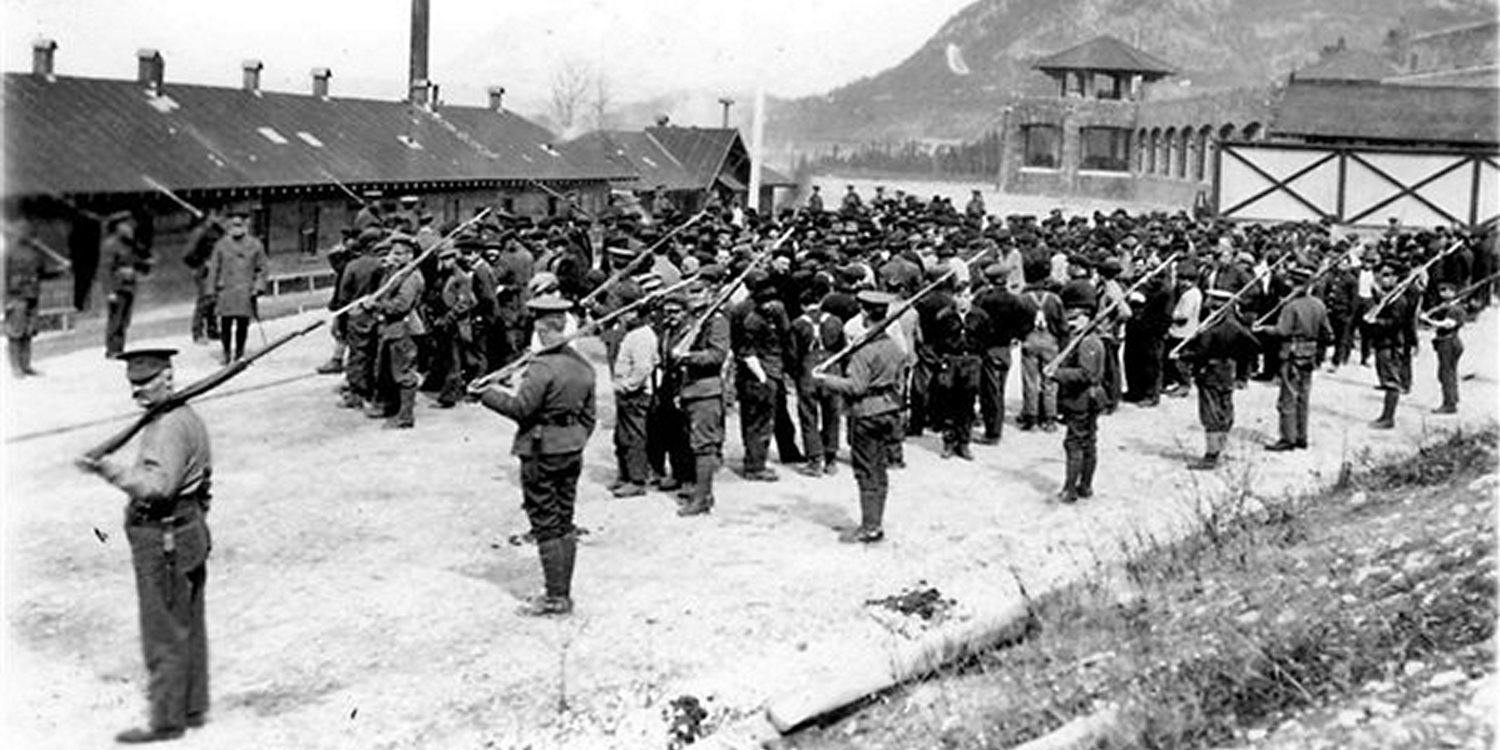 Internment camp in Banff, Alberta.
Internment camp in Banff, Alberta.
Upon Great Britain's declaration of war on Germany, the Borden Conservative government enacted the War Measures Act, in August 1914. The law's sweeping powers allowed the government to suspend or limit civil liberties and provided it the right to incarcerate "enemy aliens."
The term "enemy alien" referred to the citizens of states legally at war with Canada living in Canada during the war.
From 1914 to 1920, Canada interned 8,579 persons as so-called enemy aliens across the country in 24 receiving stations and internment camps. Of that number, 3,138 were classified as prisoners of war, while the others were civilians. The majority of those detained were of Ukrainian descent, targeted because Ukraine was then split between Russia (an ally) and the Austro-Hungarian Empire, an enemy of the British Empire. Some of the internees were Canadian-born and others were naturalized British subjects, although most were recent immigrants.
Most internees were young unemployed single men apprehended while trying to cross the border into the U.S. to look for jobs -- attempting to leave Canada was illegal. Eighty-one women and 156 children were interned as they had decided to follow their menfolk into the only two camps that accepted families, in Vernon, BC (mainly Germans) and in Spirit Lake near Amos Quebec (mainly Ukrainians).
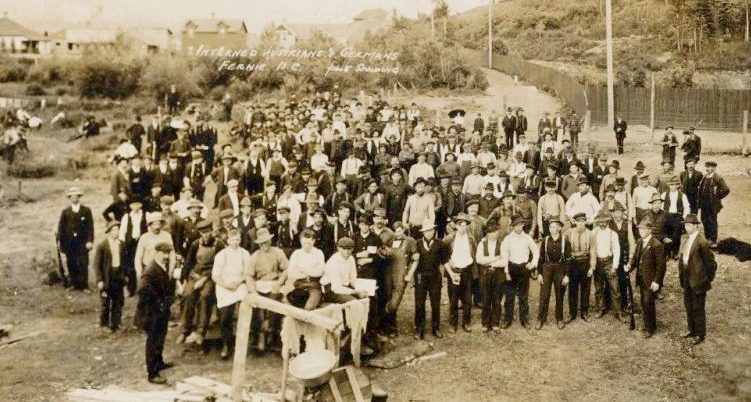 Internment camp in Fernie, BC.
Internment camp in Fernie, BC.
Besides those placed in internment camps, another 80,000 "enemy aliens," mostly Ukrainians, were forced to carry identity papers and to report regularly to local police offices. They were treated by the government as social pariahs, and many lost their jobs.
|
|
The internment camps were often located in remote rural areas, including in Banff, Jasper, Mount Revelstoke and Yoho national parks in Western Canada. Internees had much of their wealth confiscated. Many of them were used as forced labour on large projects, including the development of Banff National Park and numerous mining and logging operations. They constructed roads, cleared land and built bridges.
Between 1916-17, during a severe shortage of farm labour, nearly all internees were paroled and placed in the custody of local farmers and paid at current wages. Other parolees were sent as paid workers to railway gangs and mines. Parolees were still required to report regularly to police authorities.
Federal and provincial governments and private concerns benefited from their labour and from the confiscation of what little wealth they had, a portion of which was left in the Bank of Canada at the end of the internment operations on June 20, 1920.
A small number of internees, including men considered to be "dangerous foreigners," labour radicals, or particularly troublesome internees, were deported to their countries of origin after the war, largely from the Kapuskasing camp in Ontario, which was the last to be shut down.
Of those interned, 109 died of various diseases and injuries sustained in the camp, six were killed while trying to escape, and some -- according to a military report -- went insane or committed suicide as a result of their confinement.
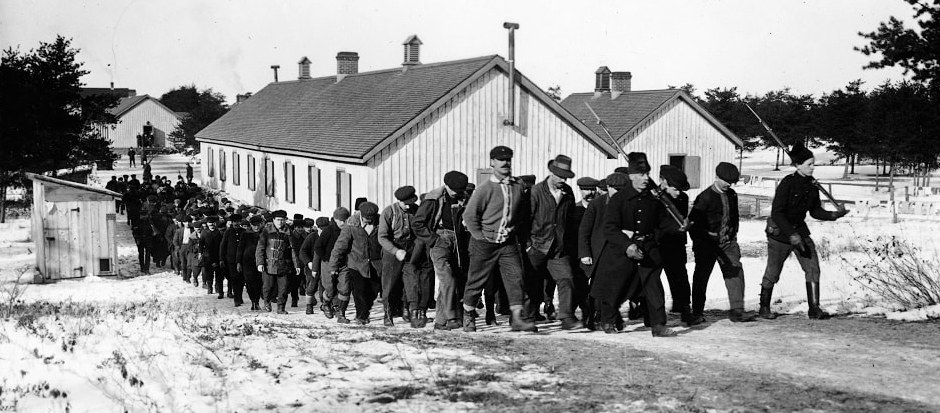 Internment camp in Petawawa,
Ontario.
Internment camp in Petawawa,
Ontario.
(Canadian War Museum, Calgary Herald, Wikipedia)
Opposition to Conscription in Canada and Quebec
When in August 1914, Britain declared war on Germany, Canada, as a dominion of the British Empire, was automatically bound to take part.
Robert Laird Borden, then Conservative Prime Minister of Canada, was eager to participate in the war. By Sunday, August 9, 1914, the basic orders-in-council had been proclaimed, and a war session of parliament opened just two weeks after the conflict began. Legislation was quickly passed to secure the country's financial institutions and raise tariff duties on some high-demand consumer items. The War Measures Act 1914, giving the government extraordinary powers of coercion over Canadians, was rushed through all three readings.[1]
Businessman William Price (of Price Brothers and Company -- predecessor of Resolute Forest Products) was mandated to create a training camp at Valcartier, near Quebec City. Some 126 farms were expropriated to expand the camp's area to 12,428 acres (50 square kilometres). "From the start of the conflict, a range of 1,500 targets was built, including shelters, firing positions and signs, making it the largest and most successful shooting range in the world on August 22, 1914. The camp housed 33,644 men in 1914."[2] At the time Valcartier was the largest military base in Canada.
Early in the war, Prime Minister Borden had promised not to conscript Canadians into military service.[3] However, by the summer of 1917, Canada had been at war for nearly three years. More than 130,000 Canadians belonging to the Canadian Expeditionary Force had been killed or maimed.[4] The number of volunteers continuously declined with the growing refusal to serve as cannon fodder for imperialist powers and as a result of the profound impact of the war efforts on the country's economy. There was pressure on all the commonwealth countries and British colonies to continue providing troops for the British imperial war effort, yet the government was not able to provide a convincing argument for working people to agree to sacrifice their lives for the British Empire.
The lack of enthusiasm for the war was such that the Borden government imposed conscription through the Military Service Act, August 29, 1917. It stipulated that "All the male inhabitants of Canada, of the age of eighteen years and upwards, and under sixty, not exempt or disqualified by law, and being British subjects, shall be liable to service in the Militia: Provided that the Governor General may require all the male inhabitants of Canada, capable of bearing arms, to serve in the case of a levée en masse." The law was in force through the end of the war.
Borden also decided that the best way to bring about conscription was through a wartime coalition government. He offered the Liberals equal seats at the Cabinet table in exchange for their support for conscription. After months of political manoeuvring, he announced a Union Government in October, made up of loyal Conservatives, plus a handful of pro-conscription Liberals and independent members of Parliament.
Borden was in his sixth year of his first term. In the months just prior to the election he engineered two pieces of legislation, stacking the Unionist side.
Under previous laws, soldiers were excluded from voting in wartime. The new Military Voters Act allowed all 400,000 Canadian men in uniform, including those who were under age or were British-born, to vote in the coming election.
The second piece of legislation, the Wartime Elections Act, gave women the right to vote for the first time in a federal election -- but only women who were the relatives of Canadian soldiers overseas. With these two laws, a vast new constituency of voters, the majority of whom supported the war effort and conscription, were suddenly enfranchised in time for the election. Borden's Unionists won that election with a majority of 153 seats, only three of which were from Quebec.


Posters to
mobilize women for imperialist war. Poster on left
calls on women eligible to vote under Wartime
Elections
Act to vote
for the Union government.
Conscription
Conscription went into effect January 1, 1918. Exemption boards were set up all over the country, before which a high percentage of men appealed their call-up for service. Besides Quebeckers, who as a whole opposed conscription because they had no intention of fighting for their colonial master, the British Empire, many Canadians across the country were also opposed, including anti-imperialists, farmers, unionized workers, the unemployed, religious groups and peace activists. By February 1918, 52,000 draftees had sought exemption across the country. The lack of support for the war was reiterated by the fact that of more than 400,000 men called up for service, 380,510 appealed through the various options for exemption and appeal in the Military Service Act.
Ultimately, some 125,000 Canadians -- just over a quarter of those eligible to be drafted -- were conscripted into the military. Of these, just over 24,000 were sent to Europe before the war's end.
Many Canadian men simply did not show up when they were called to report and join the army. Winnipeg was second only to Montreal in the percentage of men who did not report or defaulted -- almost 20 per cent of those conscripted compared to around 25 per cent in Montreal, according to reports published in the Winnipeg Telegram at the time. These men were pursued by the police and could receive heavy jail sentences if caught and tried.
Opposition to the War and Conscription in Quebec
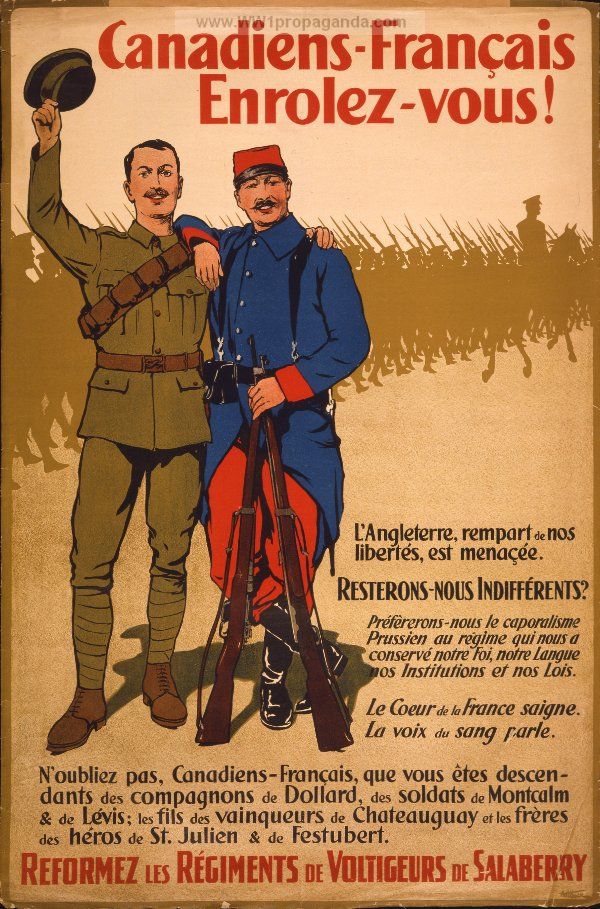

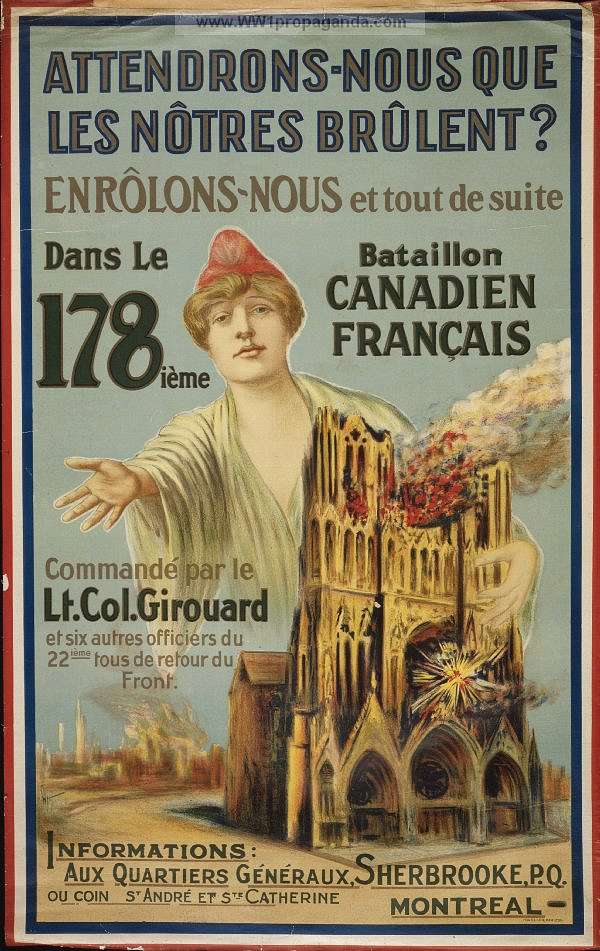
Posters
aimed at getting Quebeckers to join the British Army in World War
I.
Among
the Canadian state's clumsy chauvinist Anglo-Canadian attempts to
recruit Quebeckers to its unjust cause of imperialist war, were those
which exhorted them to enlist on the basis of loyalty to their former
colonial power, France. There were also calls to oppose tyranny by
supporting the new colonial power, Britain; and for the
people to protect themselves from foreign invasion.
On October 15, 1914, the 22nd Regiment was officially created to bolster the involvement of Quebeckers. As the only combatant unit in the Canadian Expeditionary Force (CEF) whose official language was French, the 22nd (French Canadian) Infantry Battalion, commonly referred to as the "Van Doos" (from vingt-deux, meaning 22 in French), was subject to more scrutiny than most Canadian units in the First World War. After months of training in Canada and England, the battalion finally arrived in France on September 15, 1915.[5]
In April 1916, the Van Doos participated in one of the unit's most dangerous assignments of the entire war, the Battle of St. Eloi Craters. St. Eloi was fought on a very narrow Belgian battlefield. The fierce battle resulted in heavy casualties. Following St. Eloi, the battalion prepared to take the French village of Courcelette in the Somme sector of France. The battalion suffered hundreds of casualties. To many it showed just how violent war could really be. In the months following the Somme operations, the battalion began suffering from desertion and absence without leave. According to battalion officers, the months following Courcelette witnessed a complete breakdown in troop morale. In the next 10 months, 70 soldiers were brought before a court-martial (48 for illegal absences) and several were executed by firing squad.[6]
Despite the establishment of the Van Doos, the people of Quebec, expressing their anti-war sentiment, were at the forefront of the opposition to conscription. The Canadian establishment at the time blamed Quebeckers for the "the lack of French-Canadian participation in the war."[7]
In Quebec, of the 3,458 individuals from the City of Hull called-up by military authorities who had not been granted an exemption, 1,902 men did not report and were never apprehended, for a total conscription evasion rate of 55 per cent. This was the highest evasion rate of all Canadian registration districts, followed closely by Quebec City at 46.6 per cent, and Montreal at 35.2 per cent. Further, 99 per cent of those called up by the City of Hull applied for an exemption, the highest application rate in all of Canada.[8]
War Measures Act
Quebeckers organized militant protests against attempts by the Canadian government to use its police powers to impose conscription on the working people and youth of Canada and Quebec. The Borden government responded by invoking the War Measures Act to quell this opposition. The government proclaimed martial law and deployed over 6,000 soldiers to Quebec City between March 28 and April 1, 1918.
On the evening of March 28, 1918, federal police raided a bowling alley and arrested the youth there. Faced with the arbitrariness and violence of the police, 3,000 people besieged the police station and continued their demonstration in the streets during the night.
 Thousands of demonstrators march to
Place
Montcalm on March 29, 1918.
Thousands of demonstrators march to
Place
Montcalm on March 29, 1918.
The next day, a crowd of nearly 10,000 gathered in front of the Place Montcalm auditorium (currently called Capitole de Quebec), where the conscripts' files were administered. The military, with bayonets and cannons, were called in and shortly after the Riot Act was read, giving them permission to fire.
Within the conditions of the day, the ruling elite in Canada found a wall of resistance among the working people of Quebec to being forcibly sent to war. The aspirations of the Québécois for nationhood had been put down prior to Confederation through force of British arms. Along with the subjugation of the Indigenous Peoples and the settlers in Upper Canada, the basis was laid for the establishment of an Anglo-Canadian state and Confederation. It is not hard to imagine that the Quebec working class would not look favourably on being mowed down on the battlefields of Europe in the service of the British Empire.
Notes
1. "Sir Robert Laird Borden," greatwaralbum.ca.
2. "Les débuts du camp de Valcartier et d'une armée improvisée de toutes piéces," Pierre Vennat, Le Québec et les guerres mondiales, December 17, 2011.
3. Richard Foot, "Election of 1917," August 12, 2015, Canadian Encyclopedia.
4. Ibid.
5. Maxime Dagenais, "The 'Van Doos' and the Great War," November 5, 2018, Canadian Encyclopedia.
6. Ibid.
7. "The First World War" by Sean Mills (under the direction of Brian Young, McGill University), McCord Museum website.
8. Claude Harb, "Le Droit et l'Outaouais pendant la Premi re Guerre mondiale," Bulletin de l'Institut Pierre Renouvin, Spring 2017 (No. 45), publisher: UMR Sirice.
Recruitment of Indigenous Peoples
When the First World War broke out on July 28, 1914, Canada had no official policy on the recruitment of Indigenous Peoples into the army because they did not have status as citizens. However, in 1915, as the casualties began to mount, the British government directed the Dominions to begin recruiting Indigenous people for the war effort. Australia and New Zealand, along with Canada, recruited Indigenous soldiers to fight on the side of British imperialism in the war. It is estimated that 4,000 Indigenous men and woman served in the Canadian Expeditionary Force in the First World War out of a total of some 600,000 troops from Canada. It is estimated that a third of "Status Indian" men between the ages of 18 and 45 served in the War. There are no known statistics for Métis and Inuit because the Canadian government only recognized "Status Indians" in the records.
 Many
First Nations, which were the main source of Indigenous
recruits along with a much smaller number of Métis and
Inuit, protested against the attempt to recruit them into the Canadian
colonial army and opposed the arrival of recruitment officers and the
Indian Agent on their reserves. Other
First Nations refused to participate unless they were accorded equal
status as sovereign nations and dealt with on a nation-to-nation basis
by the British Crown with which they had signed their treaties.
Many
First Nations, which were the main source of Indigenous
recruits along with a much smaller number of Métis and
Inuit, protested against the attempt to recruit them into the Canadian
colonial army and opposed the arrival of recruitment officers and the
Indian Agent on their reserves. Other
First Nations refused to participate unless they were accorded equal
status as sovereign nations and dealt with on a nation-to-nation basis
by the British Crown with which they had signed their treaties.
Some Indigenous leaders and elders also reminded the government that they had received reassurances at the time of the signing of the numbered treaties with the Crown that their youth would not be serving in any wars, specially those abroad.
As well, many Indigenous women wrote to the Department of Indian Affairs demanding that the Canadian government keep its hands off their sons and husbands and that they were needed at home.
Many reasons are given for the participation of Indigenous people in the First World War. One of the reasons was the promise of a regular paycheque, another was the argument that within the First Nations, warrior societies should play their role in assisting the Crown as their relations were with the Crown, not Canada. Another argument was that after making their contributions, Indigenous relations with the Canadian state would improve when they returned.
Indigenous soldiers took part in all the major battles that the Canadian army participated in and distinguished themselves as scouts, snipers, trackers and as front line fighters winning the admiration and respect of their non-Indigenous comrades and officers. At least 50 Indigenous soldiers were decorated for bravery and heroism. In the course of the war, some 300 lost their lives and many more were wounded and others died after returning home from the effects of mustard gas poisoning, wounds that they suffered, and diseases they had contracted in Europe such as tuberculosis and influenza.
The Military Service Act passed by the the Borden Conservative government in 1917 introduced conscription including for "Status Indians." Conscription was not only broadly opposed in Quebec, but also by Indigenous Peoples who denounced this manoeuvre by the government to disregard their status as Indigenous Peoples. In response to this opposition, the government was forced to grant Indigenous Peoples an exemption from serving overseas.
Other injustices were also imposed on Indigenous Peoples. In 1917, Arthur Meighen, Minister of the Interior as well as head of Indian Affairs, launched the "Greater Production Effort," a program intended to increase agricultural production. As part of this scheme, reserve lands that were considered "idle" were taken over by the federal government and handed over to non-Indigenous farmers for "proper use." After both non-Indigenous and First Nations protested that this was a violation of the Indian Act, the government amended the Indian Act in 1918 to make these illegal actions legal.
Post-War Brutality Against Indigenous Veterans
At the end of the war, returning soldiers, including Indigenous veterans, held high hopes that their contributions to the war effort would translate into a better future for themselves and their communities. Indigenous veterans thought that their status as "wards" of the state would be over and that they would be treated as equals. Instead they found that nothing had changed and the racism and colonial attitudes of the Canadian government remained intact.
Many Indigenous veterans returned with illnesses such as pneumonia, tuberculosis and influenza which they had contracted overseas. Those who had suffered poison gas attacks returned with weakened lungs and became more prone to tuberculosis and other respiratory illnesses. Like their non-Indigenous fellow soldiers, Indigenous veterans suffered from the trauma of the war -- which in today's terms would be called post-traumatic stress disorder -- and other illnesses such as alcoholism, which wrecked their lives and caused many problems for their families and communities. In fact, the overall standard of living in Indigenous communities declined in the years following the war as returning veterans found it extremely difficult to keep regular work and to return to their pre-war lives. In the face of these complex problems, Canada provided little support to Indigenous veterans.
Benefits and support for veterans from the Canadian government through the Soldiers Settlement Acts of 1917 and 1919, such as land and loans to encourage farming, did not extend to Indigenous veterans. To add insult to injury, through the Acts the federal government confiscated an additional 85,844 acres from reserves to provide farmland for non-Indigenous veterans.
The racist Canadian colonial state's aim of exterminating Indigenous Peoples by assimilating them was alive and well. This was expressed by the notorious Duncan Campbell Scott, architect of the Residential School System in Canada and Deputy Superintendent of the Department of Indian Affairs, who wrote in a 1919 essay:
These men who have been broadened by contact with the outside world and its affairs, who have mingled with the men of other races, and who have witnessed the many wonders and advantages of civilization, will not be content to return to their old Indian mode of life. Each one of them will be a missionary of the spirit of progress... Thus the war will have hastened that day,... when all the quaint old customs, the weird and picturesque ceremonies... shall be as obsolete as the buffalo and the tomahawk, and the last tepee of the Northern wilds give place to a model farmhouse.
|
The neglect of Indigenous veterans and other abuses of Indigenous Peoples by the Canadian state, led Haudenosaunee veteran Frederick Loft, from Six Nations on the Grand River, who had served as a lieutenant overseas in the Forestry Corps, to form the League of Indians of Canada in 1919. Before his return to Canada, Loft had met with the King and Privy Council in London to express his concerns about the way Indigenous Peoples in Canada were being treated. Under his leadership, the League of Indians fought to protect the lands and treaty rights of Indigenous Peoples.
In particular, the League of Indians fought to preserve Indigenous rights and led the battle against the "involuntary enfranchisement" changes to the Indian Act, orchestrated by Duncan Campbell Scott and passed in 1920, aimed at extinguishing Indigenous title by giving "Status Indians" the vote, while at the same time working to undermine and sabotage the work of the League of Indians and isolating and criminalizing Loft. The League also mounted legal challenges to establish Indigenous claims to hunting, fishing and trapping rights among other things.
The League of Indians was the first attempt by Indigenous Peoples in Canada to form a national organization to resist the Canadian colonial state's assault on their rights and claims. It subsequently inspired the formation of other Indigenous political organizations to battle the colonial Canadian state and its racist policies.
(With files from Indian Affairs and Northern Development Canada, Canadian Encyclopedia, Veterans Affairs Canada and Library and Archives Canada.)
Black Construction Battalion
While Black people were used by the British colonialists as cannon fodder to suppress the struggles for rights of others, their own legitimate rights and claims were marginalized and denied.
 When
the First World War broke out, Black men in Nova Scotia and
other places who tried to enlist faced racist obstacles and
justifications to keep them out. The Chief of the General Staff of the
Canadian Army at the time asked in a memo: "Would Canadian Negroes make
good fighting men? I do not
think so." When a group of about 50 Black Canadians from Sydney, Nova
Scotia, tried to enlist they were advised, "[T]his is not for you
fellows. This is a white man's war."
When
the First World War broke out, Black men in Nova Scotia and
other places who tried to enlist faced racist obstacles and
justifications to keep them out. The Chief of the General Staff of the
Canadian Army at the time asked in a memo: "Would Canadian Negroes make
good fighting men? I do not
think so." When a group of about 50 Black Canadians from Sydney, Nova
Scotia, tried to enlist they were advised, "[T]his is not for you
fellows. This is a white man's war."
In the face of repeated opposition to this state racism and discrimination, the Canadian government permitted the formation of No. 2 Construction Battalion (also known as the Black Battalion), based in Pictou, Nova Scotia. It was a segregated battalion that never saw military action because they were not permitted to carry weapons. Five hundred Black soldiers volunteered from Nova Scotia alone, representing 56 per cent of the Black Battalion. It was the only Black battalion in Canadian military history.
The Battalion was sent to eastern France armed with picks and shovels to dig ditches and construct trenches at the front, putting themselves in grave danger. They also worked on road and rail construction. Following the end of the War in 1918, the members of the Battalion were repatriated and the unit was disbanded in 1920.
According to Veterans Affairs Canada, another some 2,000 Black Canadians served on the front lines of World War I through other units, some with the armies of other countries.
Once returned, the Black veterans of the No. 2 Construction Battalion, and other returning Black veterans found that nothing had changed at home and they continued to face racism and discrimination in employment, veterans' benefits, and other social services.[1]
Note
1. The Canadian state likes to portray the participation of Black people in the Canadian military in the most self-serving manner. Veterans Affairs Canada notes, "The tradition of military service by Black Canadians goes back long before Confederation. Indeed, many Black Canadians can trace their family roots to Loyalists who emigrated North in the 1780s after the American Revolutionary War. American slaves had been offered freedom and land if they agreed to fight in the British cause and thousands seized this opportunity to build a new life in British North America."
A rosy picture, but far from reality. The enslaved people that ended up on the side of the British colonialists during the U.S. War of Independence, numbering some 30,000, served as soldiers, labourers and cooks. When the British were defeated, the British evacuated some 2,000 of these "Black Loyalists" to Nova Scotia with the promise of a better life and opportunities as free people. Others were thrown to the four winds landing on the Caribbean Islands, in Quebec, Ontario, England and even Germany and Belgium. Those the British outright abandoned in the U.S. were recaptured as slaves.
Many of the Black Loyalists landed at Shelburne, in southeastern Nova Scotia, and later created their own community nearby in Birchtown, the largest Black settlement outside Africa at the time. Other Black Loyalists settled in various places around Nova Scotia and New Brunswick.
Far from finding freedom, and new opportunities, most of the Black Loyalists never received the land or provisions that they were promised and were forced to make their living as cheap labour -- as farm hands, day labourers in the towns or as domestics. In 1791, in order to solve the "Black problem," the British Colonial authorities repatriated about half of these Black Loyalists from Nova Scotia and New Brunswick to Sierra Leone, Africa where the British wanted to found a colony and used the Black Loyalists to face the dangers, many of them dying in the process.
Those Black people who remained were used by the British colonial state in the War of 1812 to fight the Americans. Black people in Ontario and also from other places were part of a colonial militia called in to suppress the Upper Canada Rebellion in 1837.
(With files from Veterans Affairs, CBC and the Canadian Encyclopedia.)
The Case of Ginger Goodwin
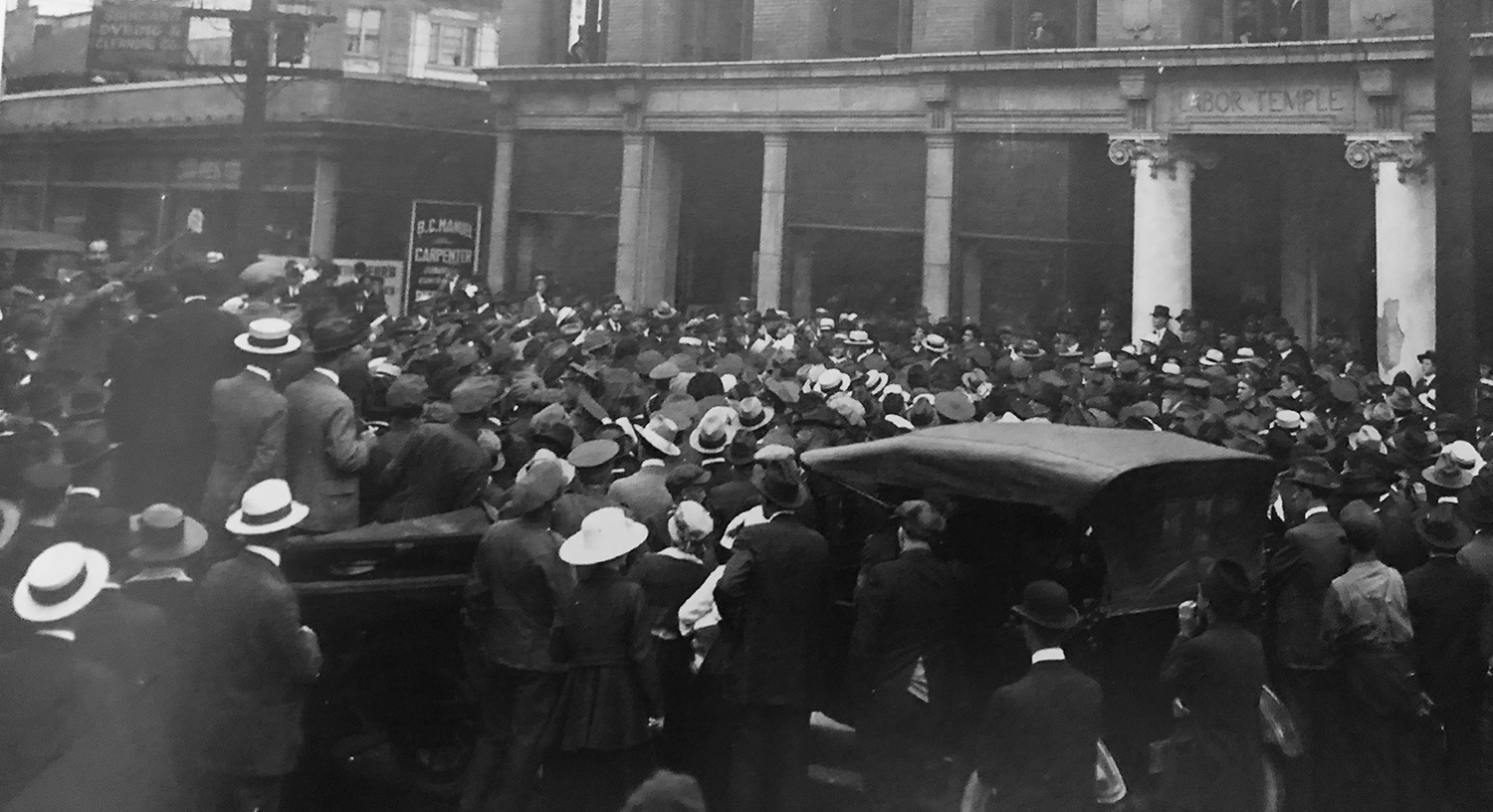 Twenty-four hour
Vancouver General
Strike was held to coincide with Ginger Goodwin's funeral,
Twenty-four hour
Vancouver General
Strike was held to coincide with Ginger Goodwin's funeral,
August
2,
1918.
Ginger (Albert) Goodwin was a coal miner from England who immigrated to Canada in the early 20th century. He worked in coal mines in Glace Bay, Nova Scotia and Michel, British Columbia before settling in Cumberland on Vancouver Island in 1910 or early 1911. He worked in the Dunsmuir coal mine in Cumberland and participated in the strike of 1912 to 1914. He was active in the United Mine Workers of America and in 1914 became an organizer for the Socialist Party.
 In
1916 he moved to Trail in the interior of BC where he
worked for some months as a smelterman for the Consolidated Mining and
Smelting Company of Canada Limited. He was the Socialist Party of
Canada's candidate in Trail in the provincial election of 1916, coming
in third, and in December of
that year was elected full-time secretary of the Trail Mill and
Smeltermen's Union, a local of the International Union of Mine, Mill
and Smelter Workers (IUMMSW). The following year he was elected as
vice-president of the BC Federation of Labour, president of IUMMSW's
District 6 and president of the
Trail Trades and Labour Council. He was proposed by the union as deputy
minister of BC's newly founded Department of Labour, but not selected.
This was a proposal supported by the trades and labour councils of both
Victoria and Vancouver.
In
1916 he moved to Trail in the interior of BC where he
worked for some months as a smelterman for the Consolidated Mining and
Smelting Company of Canada Limited. He was the Socialist Party of
Canada's candidate in Trail in the provincial election of 1916, coming
in third, and in December of
that year was elected full-time secretary of the Trail Mill and
Smeltermen's Union, a local of the International Union of Mine, Mill
and Smelter Workers (IUMMSW). The following year he was elected as
vice-president of the BC Federation of Labour, president of IUMMSW's
District 6 and president of the
Trail Trades and Labour Council. He was proposed by the union as deputy
minister of BC's newly founded Department of Labour, but not selected.
This was a proposal supported by the trades and labour councils of both
Victoria and Vancouver.
Ginger Goodwin opposed World War I for political reasons on the grounds that workers should not kill each other in economic wars. "War is simply part of the process of Capitalism. Big financial interests are playing the game. They'll reap the victory, no matter how the war ends," he said. Nonetheless, he registered for conscription as the law required and was classified as unfit. However, not two weeks following the start of a strike in Trail for the eight-hour day, which Goodwin led, he was ordered to undergo a medical re-examination and this time was classified as fit to serve.
His appeal against conscription was rejected in April 1918. Ordered to report to army barracks he refused to compromise his conscience and hid out with others resisting conscription in the hills near Cumberland where people from the town ensured they had food and supplies.
Goodwin was shot and killed on July 27, 1918 by Constable Dan Campbell of the Dominion Police, one of three members of a team that was hunting men who were evading the Military Service Act. The anger of the people of Cumberland and workers throughout the province was such that on August 2, 1918 there was a mile-long funeral procession in Cumberland, and BC's first general strike the same day in Vancouver.
 Ginger Goodwin's funeral,
Cumberland BC,
August 2, 1918.
Ginger Goodwin's funeral,
Cumberland BC,
August 2, 1918.
On June 24, 2018 in honour of Ginger Goodwin, labour martyr and war resister, on the 100th anniversary of his death, the Cumberland Museum along with the BC Federation of Labour and local unions, artists, musicians and actors, re-enacted the funeral procession as part of the annual Miner's Memorial events held from June 22 to 24. On July 23, 2018, on the occasion of the 100th anniversary of Goodwin's death, the BC government erected a monument at nearby Union Bay, the coal port that served the Cumberland mines, in honour of Ginger Goodwin for his fight for workers' rights and his opposition to conscription. A section of highway near Cumberland was named "Ginger Goodwin Way" in 1996 in his honour.
Britain
British Movement of Conscientious Objectors:
The Men Who Said
No
In the early 20th century, the concern of working people in many countries about the danger of an inter-imperialist war for the redivision of the world was profound. Britain was no exception.
Long before the outbreak of World War I, thousands of people campaigned against the escalating signs of war and, finally, against the inter-imperialist war itself. Enormous pressure was put on the people to join the war in the name of high ideals of patriotism and loyalty to the British Empire. This made enemies out of those who did not espouse these values. The same was the case throughout the British Commonwealth, including Canada. Working people's resistance to war took many forms, including conscientious objection.
The articles below highlight the organized movement of conscientious objectors in Britain, the men who courageously stood with their anti-war conscience in the face of threats, bullying, imprisonment and death. They said No! and many, including a militant women's movement, rallied to their just stand.
(With files from menwhosaidno.org, UK Parliament website)
Opposition in Britain to
the War and
Criminalization of Conscience
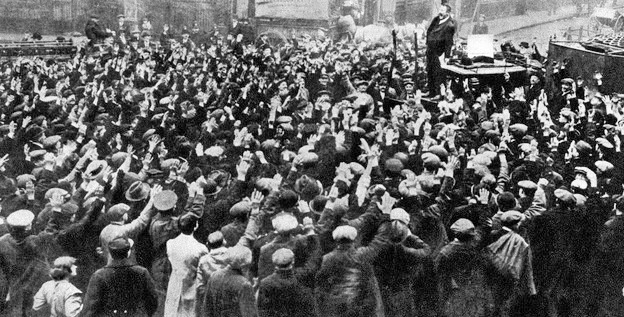 Anti-conscription demonstration in
London, January 1916.
Anti-conscription demonstration in
London, January 1916.
Conscription was widely unpopular in Britain. Trade unions, political parties and religious groups were all vocal in their opposition to its introduction but nonetheless, with ever-rising deaths and casualties, volunteer numbers had shrunk to a trickle despite the pressure on boys and men to go to war and the pressure for conscription intensified. By June 1915 supporters of conscription began to gain wider support and for the first time in British history, politicians began to seriously debate forcing millions of men against their will into the armed forces. Debates raged across the country. Trade unions lobbied against it; Members of Parliament (MPs) resigned over it.
On January 5, 1916, Britain passed the Military Service Act, which imposed conscription on all single men aged between 18 and 41, but exempted the medically unfit, clergymen, teachers and certain classes of industrial workers. A second act passed in May 1916 extended conscription to married men. Still later in 1918, the Military Service (No. 2) Act raised the age limit for conscripts to 51.
|
|
Besides this, once Britain officially declared war on August 4, 1914, the draconian Defence of the Realm Act (DORA) was passed on August 8, 1914 which made active opposition to the war a criminal offence. DORA gave the government the power to suppress the activities of the anti-war movement and to attack the right to speak and to publish. Several leading anti-war activists, including the Scottish teacher and revolutionary John Maclean, were arrested and imprisoned as a consequence.
Despite this criminalization of dissent, opposition to the war and the government's policy of forced conscription was widespread. In April 1916, more than 200,000 people demonstrated in Trafalgar Square in London against conscription. Between May 1916 and the armistice in November 1918 in Britain some 20,000 men refused to be conscripted into the British army. Several thousand of them were imprisoned for their stand. Many felt that it was wrong to kill under any circumstance and that war was not the solution to any problem.
Besides the attempt to suppress the anti-war movement through DORA, with the conscription regime in place, from the moment men received the letters demanding they present themselves at a military depot, they were deemed to be soldiers and subject to military law. This stripped men of their civil liberties, negated their right to conscience and gave the army total control over their lives for an indefinite period.
Courageous Resistance in the Face of Draconian Military Justice
With conscription in place, some 2,000
Military Service Tribunals were set up around Britain to question men
who sought to be exempted. Applicants had to fill in questionnaires
making their case. Exemptions could be given for a number of reasons
including conscientious objection -- on
domestic grounds (people with ill-health, unsupported children or
elderly relatives), or because they had important civilian jobs, such
as doctors, teachers, farmers and key industrial workers. Millions
applied for some kind of exemption and with this huge number of cases,
Tribunal hearings would
usually spend only a few minutes on each applicant before Tribunal
members made their decision. Overall, of those who applied for
exemptions, some 800,000 applied for Conscientious Objector (CO)
status, and only 16,000 or two
per cent of them were officially granted this status.
The Tribunals were appointed by the local municipal council, typically about 25 men, rarely any women, with five to six being present for the actual hearings. Although they were supposed to be impartial, nepotism in the appointments was typical. Furthermore, many Tribunal members were biased against COs and the ever present military representative made sure there was no backsliding by other members. The military need for fighting men at the front was held to be paramount.
Although the Military
Service Act included a hard fought for
but ill-defined clause on conscientious objection, many Tribunals
simply did not understand they could grant absolute exemptions from
military service (with no conditions) for COs and they often saw their
role as making sure as many men
as possible were enlisted into the army. As a result, thousands of COs
were treated unfairly and many of them would suffer harsh treatment in
prison.
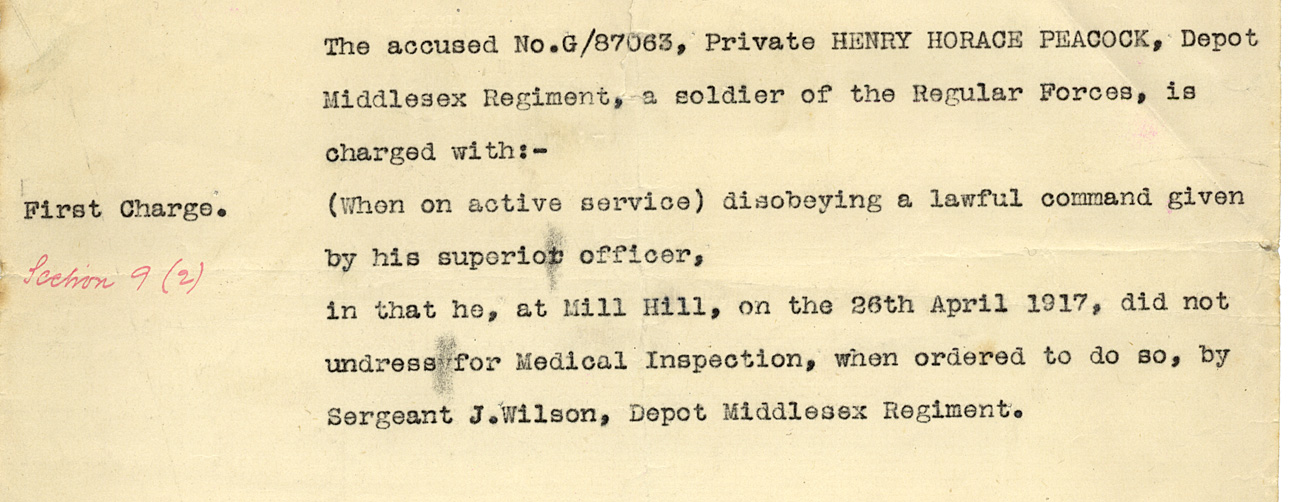
Death Sentences
In the early days of conscription, the army had no idea how to deal with stubborn, principled men who refused to obey any orders. Bullying and intimidation had failed and in May 1916, the army stepped up its threat when it shipped 50 COs from around Britain to France and sentenced 35 of them to death.
Assurances had previously been given that COs would not be subjected to the death penalty but the position of men who had been rejected by the Tribunal and sent to the Army as insincere in their objection was unclear. Did this mean that they were subject to army regulations, which prescribed death by shooting as punishment for disobedience on active service? No one knew.
Soon after the introduction of conscription, rumours about COs being sent to France to be shot began to circulate. "If they disobey orders of course they will be shot, and quite right too!" said Lord Derby, Director of Recruiting, as 17 men in Landguard Fort were released from their shackles on May 7 and put on a train to France.
On being told of this, Prime Minister Herbert Henry Asquith immediately dispatched a message to the front forbidding any execution without the knowledge of the Cabinet or sending any further COs to France, but the army had ideas of its own. While the government was publicly denying that COs had been sent to France to be shot, the army, in a show of disregard of the elected civil authorities, dispatched a further batch of men to France who were told that they were going to be shot. They were marched to the train to the sound of the military band playing the "Death March."
By moving these COs to France and closer to the front line the army believed it could intimidate them into submission. It would give the army the pretext to say that the COs had failed "under active service conditions" and it would be free to summarily execute those who continued to "disobey orders."
After weeks of painful punishments and constant abuse, the COs -- now known as "The Frenchmen" -- were formally told: Continue to disobey and face the death penalty. By June, the Army was running out of patience. The Frenchmen were marched out in groups to a camp outside Boulogne within sight of the cliffs of Dover across the English Channel and told for a final time to obey orders. When they once again refused, their sentence was read out.
One of the COs, Hubert Peet, later recalled, "I was number three on the list, and as I stepped forward I caught a glimpse of my paper as it was handed to the Adjutant. Printed at the top in large red letters, and doubly underlined, was the word 'Death.' I can hardly analyze the feeling that flashed through my mind as I caught sight of the word.'
"'The sentence of the court is to suffer death by being shot,' said the Adjutant. 'This sentence has been confirmed by the Commander in Chief' -- there was a long pause -- 'and commuted to ten years penal servitude.'"
All the COs were given the same long sentence, but they had escaped the death penalty and were sent back to civilian prisons in Britain. At the last moment, political pressure and frantic work at home by their supporters had saved their lives. The resolve and determination of the threatened COs became a rallying point for those in Britain and made it clear that their resistance would not be broken by military means.
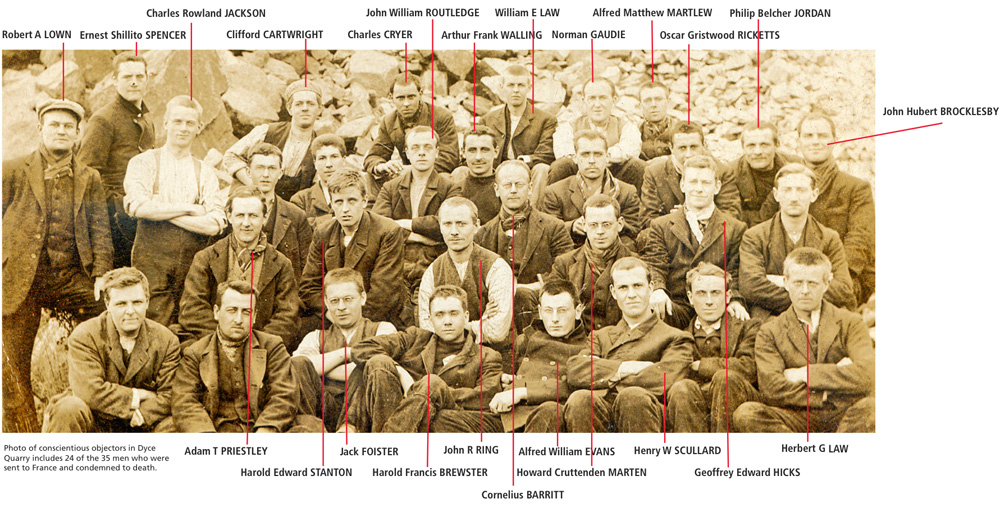 Image of conscientious objectors in
Dyce
Quarry. Includes 24 of the 35 men who were sent to France and sentenced
to death. Image from Refusing to Kill exhibition.
Image of conscientious objectors in
Dyce
Quarry. Includes 24 of the 35 men who were sent to France and sentenced
to death. Image from Refusing to Kill exhibition.
(menwhosaidno.org, UK Parliament website)
Organizing to Oppose Conscription and Defend Conscientious Objectors
 Members of No Conscription
Fellowship national committee on their way to prison, July 1916.
Members of No Conscription
Fellowship national committee on their way to prison, July 1916.
The No Conscription Fellowship (NCF) was formed to campaign against the imposition of compulsory conscription. Later, when this failed and conscription became law, the NCF provided support for conscientious objectors (COs) throughout Britain. As time went by, what stands to take in the various circumstances to affirm one's conscience required ongoing deliberation in the anti-conscription movement. The NCF provided a vital forum and converging point for COs and their defenders.
The NCF began to take shape in the autumn of 1914 when Fenner Brockway -- editor of the strongly anti-war Independent Labour Party newspaper Labour Leader -- at the suggestion of his wife Lilla, called on all those who were not prepared to take part in military service to get in touch. There was an immediate and enthusiastic response. Following a national meeting the NCF was founded in November 1914. Its "Statement of Faith" declared it an organization of men "who will refuse from conscientious motives to bear arms, because they consider human life to be sacred and cannot therefore assume the responsibility of inflicting death."
|
|
Membership began with some 300 people but rapidly grew, such that by 1915 the NCF operations had to be moved to London from the Brockways' home in Derbyshire.
The NCF was organized meticulously, keeping records of every CO, the grounds of his objection, his appearance before tribunals, civil courts, courts martial, and even which prison or Home Office settlement they were in. They also maintained contact with COs, arranging visits to camps, barracks and prisons across the country. Pickets of prisons were held. The NCF also had a press department, which constantly sought to draw the attention of the public to what was happening to COs and the ill-treatment and brutality many were subject to. They also published leaflets and pamphlets and from March 1916 a weekly newspaper called The Tribunal. The Political Department briefed Members of Parliament (MPs) and drafted questions to Ministers. The NCF worked with two other organizations: the Friends' Service Committee (the Quakers) and Fellowship of Reconciliation.
Ranged against the NCF was the full might of the British state -- the police and the army -- as well as most churches and the jingoist press which whipped up public opinion against COs or 'conchies' as they were labelled. Immense personal pressures were put on COs not just by the state, but also by communities, neighbours, friends, even families. They also had to withstand the pressure to conform when isolated in barracks, army camps and prisons. Some men were shipped to France in May 1916 as the government and army attempted to break their resolve; some were actually sentenced to death although the sentences were commuted to 10 years hard labour. By the war's end at least 100 men died while under state control. Some suffered mental breakdowns. Altogether some 20,000 men refused to fight.
Women played a crucial part in the NCF. Firstly as mothers, sisters, wives, girlfriends and friends of the men who often had to face hostility from family and neighbours. Secondly as workers in the organization itself, especially as male members were gradually moved to prisons. These included Catherine Marshall, who acted as Parliamentary Secretary; Violet Tillard who worked in the Maintenance Department, acted as General Secretary for a period and was sentenced to 61 days imprisonment for refusing to tell the police who the NCF printers were; Ada Salter; Gladys Rinder; Joan Beauchamp who was also jailed twice; and Lydia Smith who worked in the Press Department.
The final convention of the NCF took place at the end of November 1919 at Devonshire House and was attended by over 400 delegates from branches all over the country.
NCF Newspaper The Tribunal

The Tribunal was published weekly from March 1916 and at its height, had a distribution of over 10,000 copies.
It reported on the lives of COs -- from their motivations and reasons for objecting to war to their experiences at Tribunal, in prison and beyond. Named after the Military Tribunals to which the COs were subjected, The Tribunal was written clearly, and often movingly, with the intention of keeping COs and their thousands of supporters and sympathizers updated with the latest information in the struggle against conscription and militarism.
The Tribunal provided a vital service to COs all over the country, keeping them updated with the latest news, providing inspiration, guidance and examples of how an individual can successfully resist conscription. For men and women up and down the country, The Tribunal showed them on a weekly basis, that war could be resisted. Most COs found their experiences difficult, whether in a work camp, in prison or simply undergoing scorn and ridicule for their views. For these men, The Tribunal was a lifeline, linking them to the wider struggle.
The Tribunal also often played the role of advisor, suggesting to COs undergoing their tribunal hearings, court martial or magistrates court hearing, how they could best convince their jailers they were genuine men of principle. It also offered guidance on the types of work COs were expected to do -- alerting men looking at non-combatant service with the army, for example, that other COs were being forced to move armaments.
From 1916 onwards, the printers and publishers of The Tribunal -- many of them women -- were involved in a clandestine struggle against government censors. Their offices were raided repeatedly and office staff were followed by state agents, some were even imprisoned. The printing type was stolen and eventually the press on which The Tribunal was printed was confiscated and broken down for scrap iron. Through all of this, the remarkable editorial and publication staff of The Tribunal, with the support of their NCF colleagues, managed to keep the paper running.
The NCF's strong-minded and determined staff had thought ahead. They had a network of connections and sympathizers (some in other papers angry about press censorship), including two supporters who were skilled printers. Through these individuals, working in secret in a location as yet unknown, The Tribunal continued to publish.
(menwhosaidno.org)
Civil Service and
Non-Combat Roles in the
Military for Objectors
| |
Under the Military Service Act and the Military Tribunal system, conscientious objectors (COs) could have recourse to alternatives to combat, depending on the circumstances people faced and their individual conscience, including whether they considered it necessary to be imprisoned to make their point. Thus in practice, conscientious objection took a number of forms.
With Britain at war and its economy organized for that aim, it could be difficult for COs to fully extricate themselves from activities that somewhere down the line contributed to the war. Some COs were agreeable to carrying out some form of civil service in Britain in lieu of taking part in combat, with or without a direct connection to the war, known as Home Office Schemes or Work of National Importance. Others were agreeable to some non-combat roles within the military, such as the Non-Combatant Corps; some were part of the Royal Army Medical Corps. There was also the Friends Ambulance Unit set up by the Quakers.
Non-Combatant Corps
Non-Combatant Corps (NCC) of COs arose from the Military Service Act which, in its provision for COs to be granted "Exemption from Combatant Service Only," created a new type of soldier by the thousands -- the official non-combatant. Non-combatant soldiers had existed in the army before 1916, often in the form of medical workers, but prior to conscription it had never been a problem on this scale, and never without the army having a specific reason for allowing men to serve in a non-combatant capacity. Once granted "Exemption from Combatant Service Only" by their local Tribunal hearing, COs would be expected to report to barracks, either directly to an NCC unit, or to a combatant one, there hopefully to be redirected into the NCC. From the army's point of view, the NCC had the aim of freeing up soldiers behind the lines from routine labour and logistics tasks to fight on the front lines. For a CO, being in the NCC meant clearly stating that he would not be forced to kill, but would provide support for the Army. The NCC was a compromise and often contradictory. What exactly constituted non-combatant work was determined by the COs' own principles.
Members of the NCC were definitively soldiers, but could not be made to carry or use weapons, meaning in effect that they could not be made to actively participate in the slaughter of war. To some, loading munitions was unacceptable, an example of directly contributing to the murder of another human being, but to others this line could be drawn far earlier -- perhaps refusing to construct a road to help soldiers get to the front more quickly. Though taking up an "alternative" to military service, they were still in the military, and work they carried out had to be approved under their own sense of what constituted killing in warfare. Strikes, work stoppages and slowdowns characterized much of the NCC's record as COs refused to take up work that could directly support the war effort.
Despite taking a different stand than those COs who went to prison, those in the NCC stood by those imprisoned and consistently protested and agitated for their better treatment and conditions.
COs in the Royal Army Medical Corps
Many COs suggested at tribunal hearings that they would be prepared to take on Royal Army Medical Corps (RAMC) work. As an organization dedicated to saving life, it is an explicitly non-combatant branch of the Armed Forces, and as such was seen to be an acceptable position for many COs. Tribunals were happy to "oblige," recommending that hundreds if not thousands of men should join the RAMC. However, there was no mechanism to implement such a recommendation by the tribunals. Ultimately, only one in 50 men recommended to the RAMC actually joined the corps. As well, the RAMC could not train the numbers of men recommended to it. Perhaps most importantly, no army institution would be content to be swamped with thousands of COs who could have the wrong influence on regular soldiers they came into contact with.
Volunteering for the RAMC did not necessarily mean an end to a conscientious objection to warfare. Throughout the war they had to continuously oppose attempts to force them into fighting units, despite having joined under a non-combatant agreement, even to the point of being court-martialed and imprisoned for this resistance.
Friends Ambulance Unit
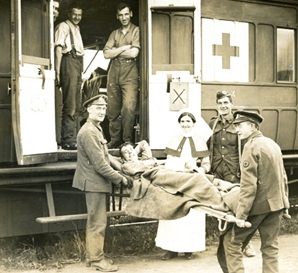 British
Quakers convened themselves in
London on August 7, 1914, to deliberate on their response to Britain's
declaration of war three days earlier. Outside the official sessions, a
group of Young Friends worked on the idea of an ambulance unit. They
were convinced that ambulance services would
be woefully inadequate, so that offering such services could save many
lives. It became operational by the fall of 1914, operating as the Home
Service in hospitals in Britain and the Foreign Service in France.
British
Quakers convened themselves in
London on August 7, 1914, to deliberate on their response to Britain's
declaration of war three days earlier. Outside the official sessions, a
group of Young Friends worked on the idea of an ambulance unit. They
were convinced that ambulance services would
be woefully inadequate, so that offering such services could save many
lives. It became operational by the fall of 1914, operating as the Home
Service in hospitals in Britain and the Foreign Service in France.
Although primarily voluntary, the Friends' Ambulance Unit (FAU) would later provide COs a means to respect their principles of non-violence and avoid prison. In 1916, conscription provided a sudden influx of COs, and a General Service section was started to offer them alternative training, if required. It also helped organize other alternative work for COs who could not join the FAU.
Home Office Scheme
The Home Office Scheme was set up in August 1916 to deal with the "problem" of thousands of COs who were refused recognition by a Military Service Tribunal. Consequently they were forcibly enlisted in the army, refused to obey military orders, were court-martialed and clogged up civilian prisons.
All CO prisoners were taken to Wormwood Scrubs Prison in London or Barlinnie Prison in Glasgow, for COs in Scotland, where they were interviewed by the Central Tribunal, and, if found "genuine," would be offered admission to the Home Office Scheme. This entailed agreeing to perform civilian work under civilian control in specially created Work Centres/Work Camps. Refusal to accept meant returning to prison to complete their sentences, then returning to the army, where renewed disobedience would entail another court-martial and another prison sentence.
Work of National Importance

Dyce Work Camp was set up
in August 1916 at quarries
north-west
of Aberdeen, Scotland. Conscientious Objectors had been released from
prison on condition that they performed "work
of national importance" -- breaking up granite rock for road
building.
What was called "Work of National Importance" (WNI) was an official alternative to military service to which COs could be assigned by a local Tribunal to secure exemption from conscription. It took the form of regular employment, but the mechanisms and rules of WNI ensured that it was also a punishment, and WNI was neither the easy nor the simple option. Accepting WNI meant accepting a part, however small, in the war effort as a "Nationally Important" industry was necessarily one that was vital in sustaining the country during the war.
A CO could not simply declare that he was exempt due to his work, the WNI option had to be secured explicitly through the Tribunal system. Provided that a CO could find (or would be found) WNI, then they would be exempted from the military for the duration of that work. Exemptions were decided on a case by case basis. Throughout the war despite frequent industrial manpower crises, no attempt was made to conscript COs into industry on a widespread and organized basis. COs were often left to their own devices to find WNI, and especially in the early months of conscription in 1916, could secure work in their local communities and report back to the Tribunal that granted them exemption. If the Tribunal approved, the exemption could be considered secure. If not -- and Tribunals frequently disagreed on what was and was not considered "Nationally Important" -- then the CO would be forced to find other employment, usually under a time constraint of 21 days.
The Tribunal system lacked oversight or a consistent way of dealing with WNI COs. It also left WNI exemptions open to appeals against them -- both from COs and the Tribunals themselves. The arbitrary nature of the Tribunal system caused significant hardship and difficulty for the COs it affected. Exemptions could be revoked, changed or qualified, with Tribunals withdrawing exemption for any infraction -- a wage they considered too high, or that a CO was working too close to home. Tribunals could rule that a CO would have to work at a certain distance from their home, usually done arbitrarily to make finding and keeping WNI a punishment.
Overall, around 4,500 COs were sent to do WNI, and they came from every single area, class and motivation that produced COs.
(menwhosaidno.org, Quakers)
Imprisonment
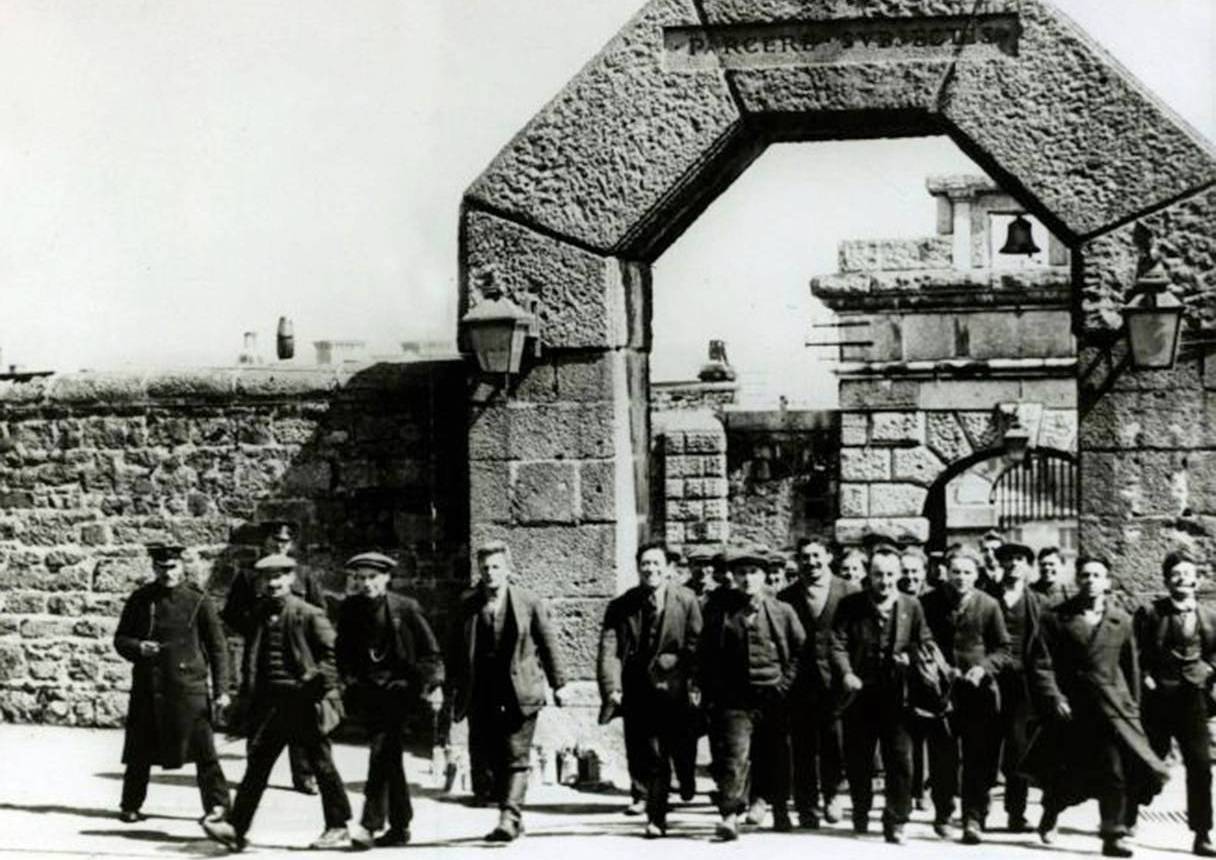 A group of Conscientious Objectors
leaving Dartmoor Prison.
A group of Conscientious Objectors
leaving Dartmoor Prison.
Many conscientious objectors (COs) ended up in prison. For some, this was a conscious choice made at the start of conscription to refuse participation in any activity they felt would contribute to the British war effort, whether in the Non-Combatant Corps or in the various Home Office Schemes. They were known as the Absolutists. For others, imprisonment was the ultimate destination they reached as their thinking developed and they considered what stand to take to be effective in opposing the war and conscription. Still others were imprisoned because the army had violated their right to participate in the military in non-combat roles and they had been court-martialed for refusing orders.
At the time of conscription in 1916, the notorious conditions of British prisons were only marginally less grim than at the end of the 19th century. Punishment was their overriding function. Many spent time in solitary confinement (today, extended periods of solitary confinement are considered a form a torture and barred under international law). Those sentenced to hard labour were given pointless and arduous tasks. To a lesser extent the slave labour of those imprisoned was also used to generate revenue for the state. The diet was poor, cells were cold and often damp. The COs' experience in prison was not dissimilar to that of other inmates with the exception of the fact that their "crime" was to refuse to commit murder. These conditions were shocking to many COs, many of whom challenged the system. After the war, some would go on to work and campaign for prison reform.
A common occupation for COs in their solitary cells was to sew mailbags. As the skin hardened on their fingers some began to wonder what precisely was the difference between sewing mailbags in a solitary cell and doing some other work on a Home Office Scheme. For example, after his third court-martial in May 1917 and a sentence of two years hard labour, Clifford Allen wrote to the No Conscription Fellowship (NCF) from his cell in Parkhurst camp on Salisbury Plain explaining his thinking. He also wrote a letter to Prime Minister David Lloyd George giving notice of his intention:
Before I am removed to prison I think it is right to make known to you that, like other men similarly situated, I have recently felt it my duty to consider carefully whether I ought not for the future to refuse all orders to work during imprisonment. I have decided that it is my duty to take this course. This will mean that I shall be subjected to severe additional punishment behind prison doors. Provided I have the courage and health to fulfil this intention, I shall have to spend the whole of my sentence in strict solitary confinement in a cell containing no article of any kind -- not even a printed regulation. I shall have to rest content with the floor, the ceiling and the bare walls. I shall have nothing to read, and shall not be allowed to write or receive even the rare letters or visits permitted hitherto, and shall live for long periods on bread and water.
Such a stand was said to have caused consternation for the National Committee of the NCF, which had only just began persuading COs from work striking. It felt that its campaign to secure socially useful work for COs through the Home Office Schemes could be jeopardized. Nonetheless the NCF published Allen's letter in The Tribunal which was followed by a vigorous correspondence. Some felt that "To win through we must succeed in influencing the heart and mind and conscience of the nation and the authorities. We have to convince them: we cannot threaten or compel them. Our methods must be those that will stand the test of time." Despite such serious and deeply felt differences during its years of work, the men and women of the NCF continued to effectively work for a broadly common cause.
The Wakefield Experiment
The Wakefield Experiment was one of the last, and shortest-lived, attempts made by the government to encourage Absolutist COs to compromise on their principles. It underscored the harsh treatment of the COs and the violation of their rights, and the unjust nature of Britain's participation in the war as a whole.
August and September 1918 were awash with rumours that a new way of dealing with Absolutist COs was on the horizon. Many "two year men" had begun to be released from prison, especially those whose health had been destroyed by prolonged imprisonment. Change seemed to be in the air, and with the war clearly entering its terminal stages, COs began to look forward to an imminent release.
The Wakefield Experiment was devised to prolong the imprisonment of COs, and rapidly became a political embarrassment for the government as the war wound to a close. It had been planned as a way to involve COs in their own punishment, allowing them to essentially manage their conditions in prison, and therefore keep them locked up without significant protest until the government saw fit to release them. Though a significant compromise on the part of the government, its purpose was merely to be a stop-gap measure intended to mollify many of the concerns and protests that had built up over the past two years.
It began with men who were long-standing COs who had already served multiple sentences being gathered into groups in prisons around the country. On Friday, August 30, 1918, the first of these groups were moved and ten Absolutist COs in Durham Prison, all having served more than two years, were told that they were to be transferred to Wakefield Civil Prison. These men were given no choice, and little chance to inform anyone of their whereabouts. Prison officials at Durham had no idea of the conditions at Wakefield, and for many, it would have seemed to be simply another prison transfer. More men would be transferred from Dorchester prison.
Initially, conditions seemed better at Wakefield. Locks had been removed from the prison doors and COs had freedom of movement within the prison itself. They could even freely buy writing materials and tobacco with a little pocket money. They were allowed to wear civilian clothing, allowed to see visitors and accept parcels, letters and food from them. The conditions seemed good -- not a full release, but certainly better than prison. The mystery was in why it had all happened -- and in the selection of certain men for transfer. In September, around 120 men were brought in small groups to Wakefield, and handed over to the wardens, who had barely any more information on the experiment than the prisoners themselves.
The relaxed conditions were earmarked as "temporary" and though COs were freely allowed to report on them from inside, no clear plan seemed to have been made for what the COs would do, how they would be treated, or how the prison would be run. They were initially assigned work to maintain the prison and set up a canteen, an agreeable change from the hard labour of other prisons, and the rules that governed their lives were lax. COs had dedicated free time and working hours and could smoke fairly freely, in return for agreeing to not damage prison property and diligently work at assigned tasks
From the point of view of the Governor (and government), the conditions of the scheme would have seemed reasonable. If long-serving COs could expect similar treatment around the country, it must have appeared that the problem of the Absolutists was at long last solved.
The Wakefield Revolt
The largely liberal rules at Wakefield did not meet with universal support among the men experiencing them. Many COs wrote to the NCF and other organizations explaining their position. There seemed to be no clear plan of what to do with the COs held there, and in discussion together the COs decided to wait it out in order to see exactly what kind of system would be drawn up around them. It seemed in many ways similar to the Home Office Scheme, except with no written agreement and no freedom to travel outside of the prison.
Work details were light, and with no locks on prison doors and plenty of free time, the imprisoned COs held long discussions over what they would and would not do while at Wakefield. Opinion was divided as to why COs were there in the first place -- either to put them under industrial conscription, or to segregate these "Absolute-Absolutists" from the general population, or perhaps even to acknowledge that the prison system had failed. They agreed that they would not submit to prison discipline, would not be put to work they had not agreed to and began to plan a strike. After more than two years of prison, Absolutists were not about to compromise now -- even in the seemingly limited way demanded of them at Wakefield.
It only took one more week for mystery to resolve into fact, and for the Wakefield Experiment to come crashing to an end.
After a period of settling in, the Wakefield men had taken it upon themselves to organize and run the prison as they wished. Committees divided the labour of prison upkeep and cordially invited the wardens to help if they wished. The Governor, with no instructions on what to do, allowed the Chairman of the Committee, Walter Ayles, to represent the official Home Office plan for the prison to the assembled men. Ayles presented the rules and regulations on how COs in Wakefield would be expected to work and live on September 16. There had been no great threat of exceptional mass punishment, simply that if the rules of the new scheme were not followed, men would be returned to prison. The position was simple. In exchange for their work, COs would stay in Wakefield and be managed, in all essential respects, by themselves.
Two days later, with a resounding rejection of the principle of compromising conscience for better conditions, all but six of the 125 COs were back in locked cells, soon to be returned to the prisons they came from.
The final piece was the creation of the "Manifesto of the Absolutists at Wakefield." Not only had the COs held there organized and discussed their thoughts, but had formed a committee which wrote, drafted and distributed a clear statement of intent. The Manifesto signaled the clearest statement of the Absolutist position. Despite better conditions, no manner of compromise would fulfill the aim of the Absolutists: unconditional liberty and discharge from the army. The Manifesto explained that the government: "take for granted that any safe or easy conditions can meet the imperative demands of our conscience. No offer of schemes or concessions can do this. We stand for the inviolable rights of conscience in the affairs of life."
The 123 men at Wakefield refused any form of compromise with the government and demanded either release, or a return to prison. No change in their circumstances could win them over and put them to work.
The position outlined in the Manifesto had been the Absolutist stance since before conscription had become law, and the rejection of the Wakefield Experiment was the last attempt by the government to subvert or undermine it. The Wakefield men returned to prison, and the incarceration of COs continued as before.
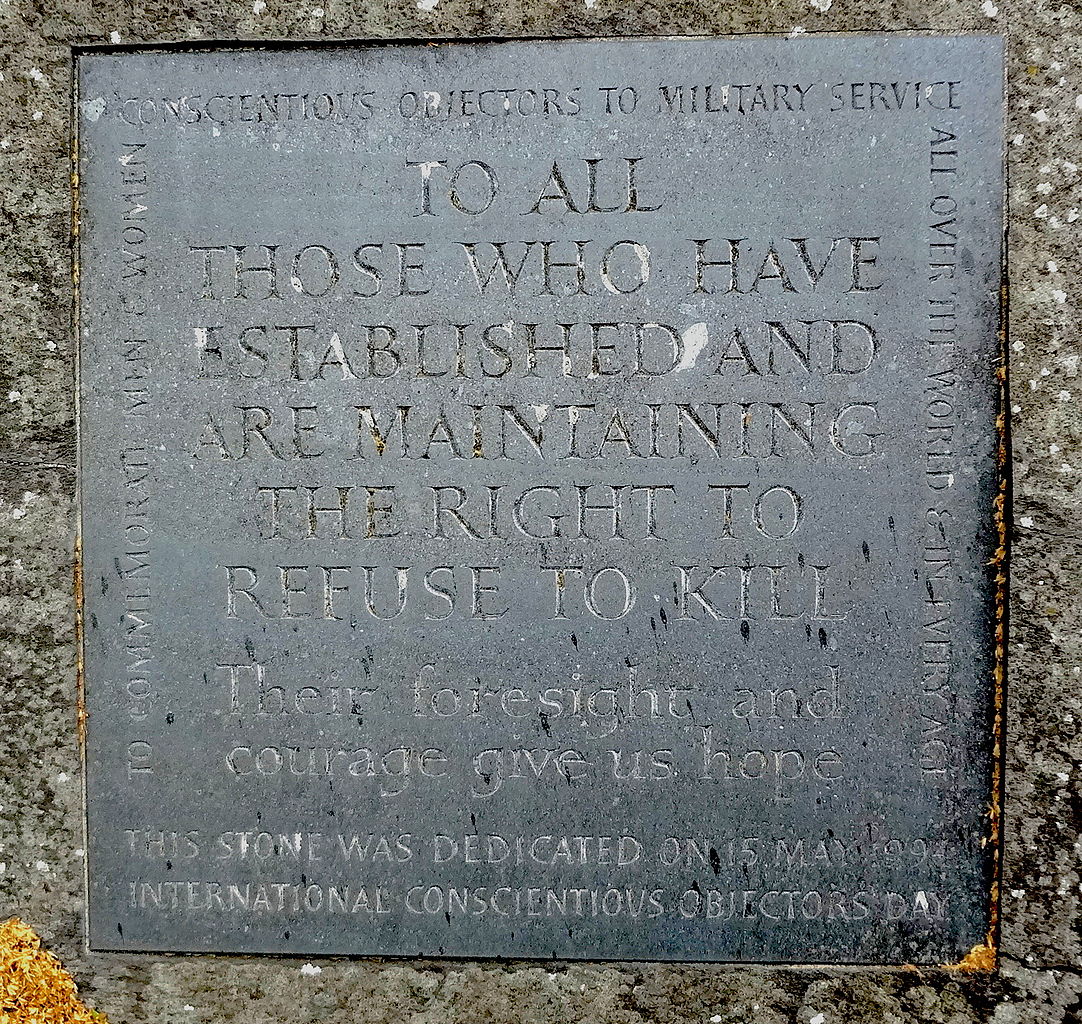
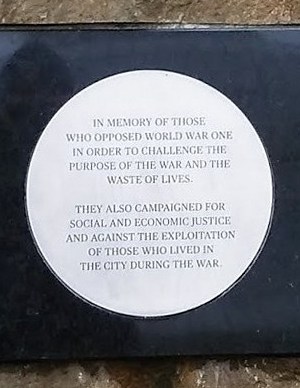 Plaques to
conscientious objectors: Left
in Tavistock Square, London and right, in Glasgow, Scotland.
Plaques to
conscientious objectors: Left
in Tavistock Square, London and right, in Glasgow, Scotland.
(menwhosaidno.org)
(To access articles individually click on the black headline.)
Website: www.cpcml.ca Email: editor@cpcml.ca

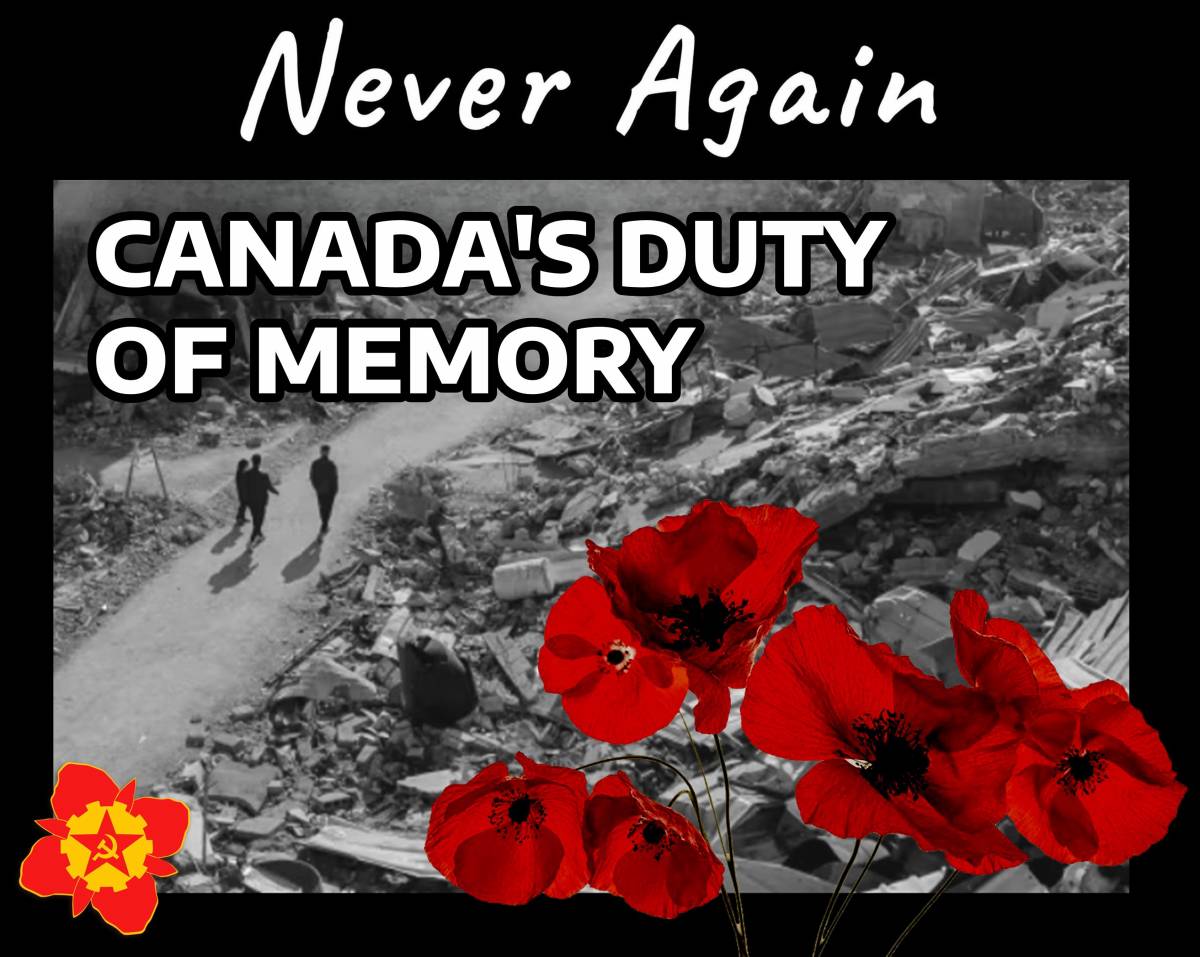

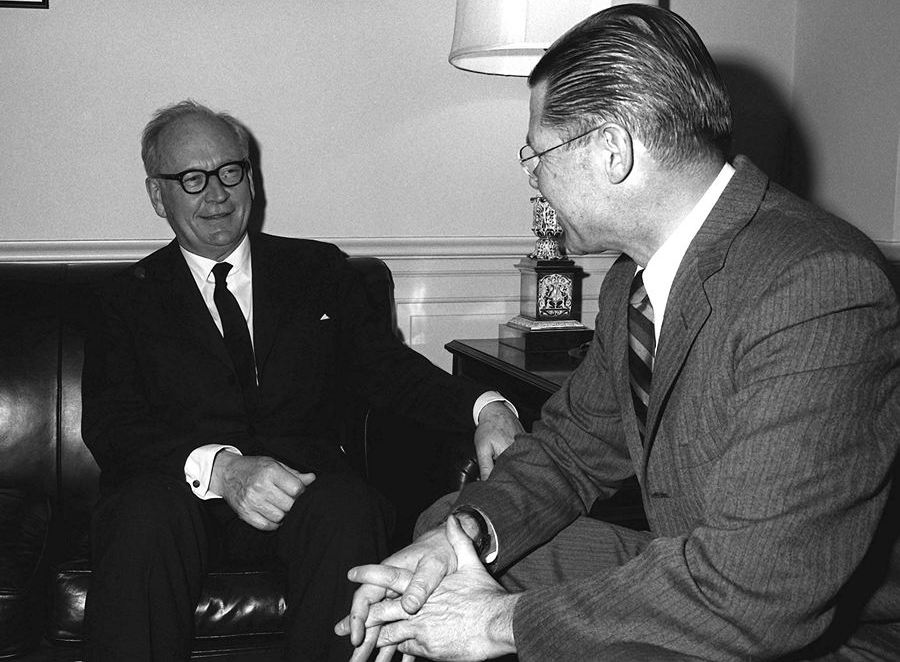 Adolf
Heusinger
with then U.S. Secretary of Defense Robert McNamara at the Pentagon,
Adolf
Heusinger
with then U.S. Secretary of Defense Robert McNamara at the Pentagon, 
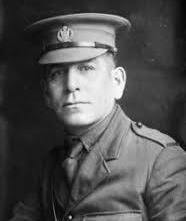 Haudenosaunee
veteran Frederick Loft founded League of Indians in 1919.
Haudenosaunee
veteran Frederick Loft founded League of Indians in 1919. 